
About UsThe Numismatic Bibliomania Society is a non-profit organization devoted to the study and enjoyment of numismatic literature. For more information please see our web site at coinbooks.org SubscriptionsThose wishing to become new E-Sylum subscribers (or wishing to Unsubscribe) can go to the following web page link MembershipThere is a membership application available on the web site Membership Application To join, print the application and return it with your check to the address printed on the application. Membership is only $20 to addresses in the U.S., $25 for First Class mail, and $30 elsewhere. For those without web access, write to: David M. Sundman, Treasurer
AsylumFor Asylum mailing address changes and other membership questions, contact David at this email address: dsundman@LittletonCoin.com SubmissionsTo submit items for publication in The E-Sylum, just Reply to this message, or write to the Editor at this address: whomren@gmail.com BUY THE BOOK BEFORE THE COIN |
- WAYNE'S WORDS: THE E-SYLUM NOVEMBER 30, 2014
- NEW BOOK: U.S. SHELL CARDS 1867-1880
- NEW BOOK: COINS OF ENGLAND, 50TH EDITION
- NEW BOOK: DICTIONARY OF ENGLISH NUMISMATIC TERMS
- MORE ON U.S. CIVIL WAR STORE CARDS, 3RD EDITION
- BOOK REVIEW: PLEASURE & PROFIT
- THE UPCOMING BOOK PROJECTS OF Q. DAVID BOWERS
- PETER PRESTON-MORLEY RECALLS DAVID LITRENTA
- U.S. MINT DIRECTOR GEORGE N. ECKERT
- NOTES FROM E-SYLUM READERS: NOVEMBER 30, 2014
- NOTES FROM PAUL BOSCO ON NORTON, CHAMBERLIN AND PLATE MONEY
- ON PERSPECTIVE IN MEDAL DESIGN
- ELIASBERG'S 1873-CC DIME
- IS 1876 PRIZE COUNTERSTAMP OF BRITISH ORIGIN?
- MORE LUCITE-ENCASED COINS: SPELLMAN, BEISTLE
- STACKS BOWERS OFFERS GOLD LINCOLN MEDAL AND MEDALET SET
- U.S. MINT ENGRAVER ENGELHARDUS VON HEBEL
- ENOUGH WOODEN NICKELS TO FLOAT A BATTLESHIP
- COMMEMORATIVE COIN FOR NORTH BAY SHOE STORE
- SOME INTERESTING MEDALS: NOVEMBER 30, 2014
- NATIVE AMERICAN $1 COIN LASER TREATMENTS
- QUERY: GREAT SEAL OF MASSACHUSETTS ON A SPOON
- JAMES WATSON'S 1962 GOLD NOBEL PRIZE MEDAL
- AUCTION HOUSES ACCUSED OF "SUPPORTING TERRORISM"
- ALEXANDER ON THE "ISLAMIC STATE" COINS
- NUMISMATIC TRENDS OF THE 21ST CENTURY
- SOME RECENT COINS DESIGNS: NOVEMBER 30, 2014
- SRI LANKAN ADMINISTRATIVE DISTRICTS COINS
- STACK’S BOWERS ROCKWAY COLLECTION PART II
- MORE COMMEMORATIVE MEDAL SELECTIONS FROM BALDWIN'S
- SELECTIONS FROM ROSENBLUM SALE #44B
- ARTICLE PROFILES CANADIAN COIN ARTIST TIM WHISKEYCHAN
- HOW POLYMER BANKNOTES WERE INVENTED
- BLOWING ON BANKNOTES TO SEE IF THEY'RE GOOD
- NIGERIAN MUSLIMS IRKED BY BANKNOTE
- THE SS CENTRAL AMERICA'S BIOLOGICAL TREASURE
- HOW STUART LITTLE RESCUED A LOST PAINTING
- PAINTING DEPICTS CHILD WITH COIN
- SLATE ARTICLE ON PURRINGTON'S U.S. PAPER MONEY
- 2003 LIBERTY PLATINUM GUITAR PICK
- LITHUANIA BUILDS WORLD'S LARGEST COIN PYRAMID
- FEATURED WEB SITE: JAMAICA CURRENCY
Click here to access the complete archive
To comment or submit articles, reply to whomren@gmail.com
WAYNE'S WORDS: THE E-SYLUM NOVEMBER 30, 2014

No new readers to speak of this slow holiday week; we now stand at 1,794 subscribers (another great year for U.S. coinage).
This week we open with three new books and one review. Other topics include shell cards, wooden nickels, David Litrenta, George Eckert, Louis Eliasberg, Tim Whiskeychan, Cardinal Spellman and the book projects of Q. David Bowers.
To learn more about the National Medal of Science, Engelhardus von Hebel, the Great Seal of the Commonwealth of Massachusetts, Warsaw sugar coupons, dentils and denticles, perspective in medal design, numismatic trends of the 21st century, and the Ladies in Waiting of Emperor Norton's Court, read on. Have a great week, everyone!

E-Sylum Ground Zero - The Wayne K. Homren Numismatic Library
Wayne Homren
Editor, The E-Sylum

NEW BOOK: U.S. SHELL CARDS 1867-1880
John Mutch writes:
On Monday the postalperson delivered my copy of the Q. David Bowers' Shell Card book - as announced in the Nov-Dec 2014 TAMS Journal, p.171. It looks wonderful!
Alan V. Weinberg writes:
A visually impressive book. The imaging is as good as it gets, particularly for some of the more difficult to photograph pieces. The text and narratives are excellent.
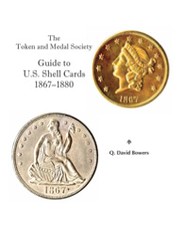 As
Q. David Bowers points out in chapter 1 of this masterful study, there are few areas of American numismatics that haven’t been examined, often in
great detail, by collectors and historians. Bowers himself is well known as a researcher par excellence. His work in many coinage series has yielded
a library of standard references, their subjects ranging from Buffalo nickels to gold double eagles, from the earliest colonial American tokens to
the most recent commemorative coins. But until the publication of this work, the The Token and Medal Society Guide to U.S. Shell Cards
1867-1880 , no book-length study of these fascinating advertising tokens had been attempted by Bowers or anyone else.
As
Q. David Bowers points out in chapter 1 of this masterful study, there are few areas of American numismatics that haven’t been examined, often in
great detail, by collectors and historians. Bowers himself is well known as a researcher par excellence. His work in many coinage series has yielded
a library of standard references, their subjects ranging from Buffalo nickels to gold double eagles, from the earliest colonial American tokens to
the most recent commemorative coins. But until the publication of this work, the The Token and Medal Society Guide to U.S. Shell Cards
1867-1880 , no book-length study of these fascinating advertising tokens had been attempted by Bowers or anyone else.
Shell cards were a post–Civil War phenomenon, mostly hailing from New York, Boston, Chicago, and other large United States cities in the East and Midwest, although smaller quantities came from other regions. Coin-sized in diameter, these pocket-piece advertising tchotchkes often had coin-like designs, a feature that made them eye-catching and popular. They were constructed so that a business’s advertisement was either embossed on one side or inserted, in print, a few under a thin mica window.
From early on these advertising tokens were well received. Those that came with a small mirror fixed to one side were useful; those with a coin-like Liberty Head, Liberty Seated figure, or heraldic eagle warranted a double-take; and no matter the design, a shell card was more substantial—less ephemeral—than a paper coupon, printed card, or other throwaway advertisement. By the 1870s numismatists were actively seeking shell cards as collectibles. Early studies of them as such included auction-lot cataloging and listing by coin dealers and collectors, such as J.M. Tilton of Cincinnati.
These early efforts were thin in details. In 1920 Harry A. Gray made a more in-depth study, by die and variety, in The Numismatist, the journal of the American Numismatic Association. These foundations were built upon by later researchers and enthusiasts, the likes of Ralph Mitchell, Russ Rulau, Arlie Slabaugh, George Fuld, David Schenkman, and Steve Tanenbaum.
From the 1960s on, old and previously unpublished collections came to light, new varieties were cataloged and added to the hobby community’s knowledge base, and researchers shared their findings in the Token and Medal Society’s TAMS Journal and other publications. But no magisterial treatment of shell cards—their history, their motifs, their die varieties, their manufacturers and distributors, and the like—was compiled, until now.
Only Dave Bowers, with his steel-trap memory, extensive and well-maintained research files, and encyclopedic knowledge of all things numismatic, could have authored this richly layered volume. His study goes far beyond a mere listing of design elements and assignment of catalog numbers. The famous Bowers style is not simply to physically describe a coin, token, or medal, but to firmly establish it within its historical context. He tells the story of each shell card’s issuer and its birthplace, painting a picture of, for example, Macon, Georgia, in the early 1870s, where B.A. Wise & Co.—“Importers of Table and Pocket Cutlery, Stoves, and House Furnishing Goods”—ballyhooed their wares with published cries of “Cooking Stoves! Cooking Stoves!” and “Hoes! Hoes! Four hundred dozen Scovill Pattern English Hoes!” (in Southern Farm and Home magazine).
Where was each shell card issued? Who distributed it? How large is it; is the edge plain or does it have tiny holes so the interior can serve as a pincushion? Did its maker also create Civil War tokens, during the recently subdued interstate quarrel? Was the shell card known to early collectors, and if so, where has it been written up? In earlier catalogs, were any mistakes made that modern research has corrected? All of these queries are within Bowers’s purview. He provides answers where a less disciplined researcher might not even see questions.
In the The Token and Medal Society Guide to U.S. Shell Cards 1867-1880 , Q. David Bowers takes a subject that might otherwise be esoteric—understood and valued only by specialists—and broadens its appeal to touch on every facet of American life in the 1860s and 1870s. The past being prologue as it is, we cannot overestimate the value of that interdisciplinary approach. Bowers’s shell cards may be rare, fragile, and small enough to hold in your hand, but they’re only windows; his true subject is nothing less than the rich and colorful panorama of America itself.
Dennis Tucker
Atlanta, Georgia
Alan V. Weinberg adds:
In my opinion the title of the book should just be "Guide to U.S. Shell Cards 1867 - 1880 " The cover reference to The Token and Medal Society is in smaller letters above the title and NOT part of the title.
I'm surprised they left out "Embossed" and separated the term "Shellcards" into two words. I'd always seen them for many decades referred to as "Embossed Shellcards".
Dave Bowers writes:
This was an especially fun/challenging project as no BOOK or in-depth study had ever been done on this very extensive series. It was very stimulating to try to sort out who did what. After I finished the basic book, Evelyn Mishkin (who did much to get the Civil War Token Society's third edition of the Civil War Storecard book, coordinated by John Ostendorf, out the door) did remarkable things with refining and research, and Bill Hyder did the very impressive graphics.
I think that some of the specialties or niche areas of numismatics will expand greatly. I love a gem 1879 $4 Stella worth the best price of $200,000, but for the same price someone with a quotient of intellect and love for history could spend 10 years building a collection in some out-of-the-way series.
From the Token and Medal Society (TAMS) web site:
TAMS Guide to U.S. Shell Cards 1867-1880 by Q. David Bowers.
Hard-bound, 360+ pages, full color catalog of U.S. Shell Cards.
The first book-length treatment of these early examples of American advertising tokens. Over 1,000 shell cards described and most illustrated in
color. The study includes a history of shell cards, their makers, and rarity information for many pieces.
Price: $55.00 TAMS Members Price: $40.00
Shipping and Handling for this book: $5.00
To order a copy, see:
www.tokenandmedal.org/Books/Books.html
To read the earlier E-Sylum article, see:
NEW BOOK: U.S. SHELL CARDS 1867-1880 (www.coinbooks.org/esylum_v16n15a03.html)
NEW BOOK: COINS OF ENGLAND, 50TH EDITION
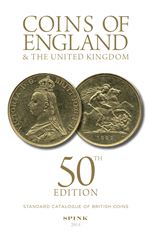 Coins of England & the United Kingdom’s landmark 50th edition will be published in early December. The only reference guide to cover every
major coin from the Celtic period to the present day will, for the first time, be split into two volumes covering pre-decimal and decimal issues.
Coins of England & the United Kingdom’s landmark 50th edition will be published in early December. The only reference guide to cover every
major coin from the Celtic period to the present day will, for the first time, be split into two volumes covering pre-decimal and decimal issues.
The two books will be sold as a set for £30.00 and can be ordered directly from Spink Books’ website here: www.spinkbooks.com/product.php?xProd=525. For a limited time Spink will be offering free postage on all orders of Coins of England delivered in the UK.
Coins of England is an essential guide for beginners, serious numismatists and anyone with an interest in British Coinage. It will also be available as an e-book exclusively through iTunes.
Coins of England and the United Kingdom 50th Edition 2015 by Skingley, P. (ed.) Hardcover, 2 volumes, colour illustrations throughout
SPINK
69 Southampton Row
London WC1B 4ET
United Kingdom
Tel: +44 (0)20 7563 4046
Fax: +44 (0)20 7563 4066
www.spink.com
NEW BOOK: DICTIONARY OF ENGLISH NUMISMATIC TERMS
 H. E. Manville, Dictionary of English Numismatic Terms. Spink London 2014. 301 pages. 21 x 30
cm. Hardback with dust jacket. ISBN 978-1-907427-36-7. £45,00.
H. E. Manville, Dictionary of English Numismatic Terms. Spink London 2014. 301 pages. 21 x 30
cm. Hardback with dust jacket. ISBN 978-1-907427-36-7. £45,00.
One of the most underrated tasks is writing dictionaries. Even in Germany, where there is much talk of the Duden, hardly anybody knows that Konrad Duden, its author, was one of the protagonists of public instruction who tried to make it easier for all people to write by using his collection of accurately written words. Konrad Duden worked in a period of time when there was a fierce discussion going on about whether or not a word’s language history should be reflected in its orthography. He preferred a phonetic spelling but in the end every word was something of a compromise with Duden, in place of future generations of Germans, contemplating the right kind of orthography individually.
Why this lengthy preface? Well, it is quite simple, it would be much too little to just introduce the Dictionary of English Numismatic Terms as mere “Dictionary”, and it would not remotely get to the heart of the matter. It is much more. It is the attempt to organize the entire knowledge on British and Irish numismatics in one volume with almost exactly 300 pages.
Responsible for this compilation is H. E. Manville, renowned expert on British and Irish numismatics, who was also awarded the book prize of the International Association of Professional Numismatists for his monograph “Tokens of the Industrial Revolution”. He did not only write the “Dictionary of English Numismatic Terms”. Rather, it is the fifth and final volume of the impressive “Encyclopaedia of British and Irish Numismatics”. In three volumes a vast collection of material was assembled, each consisting of an annotated catalog of auction sale catalogs, archaeological and numismatic journals and printed books. The fourth volume is a biographical lexicon. The encyclopedia’s last volume is now devoted to numismatic technical terms.
That already sets the scene. Anyone who expects to find absolutely all numismatic terms here might be disappointed. When it comes to English numismatics, though, it is hard to find anything more comprehensive than this hoard of knowledge.
For example, you know the phenomenon that two persons are depicted on the same coin with one bust depicted behind the other one. What is the correct English term for this kind of artistic convention? Catalogs often refer to it as “jugate busts” and this is certainly an option. As a matter of fact, this phenomenon could be described in three different ways. “Jugate” still harks back to the Latin word “iugum”, i.e. the yoke under which two draft animals are bound, on an equal footing. Another, neutral term would be “conjoined”. But when you look up the heraldic term “accolated” you will find this information about the use of the word in question: “Two persons of unequal status presented facing the same way and overlapping, with the one of higher status in front.” Thus, the word “accolated” not only describes the way in which the persons are depicted but also indicates a special hierarchy. Anybody preferring “accolated” to “jugate” or “conjoined” in the future will do so deliberately, with the intention of hinting at this hierarchy.
The art of writing a dictionary requires a fine command of language and a profound insight into the different aspects of a subject. The author is well-aware of the snares of his work and has thus invited renowned guest authors to contribute as well, on such comprehensive terms as “Anglo-Saxon Coinage”, “Irish Coinage” or “Numismatic Literature”.
In conclusion, the Dictionary of English Numismatic Terms is a highly useful book which can be consulted for every single key word not only in cases of doubt. Like all good dictionaries, this one, too, constantly tempts the reader, upon opening, to jump from one word to the next and, in the process of reading, acquire much knowledge on the subject described.
For more information, or to order, see:
Dictionary of English Numismatic Terms by Manville, H. E.
(/www.spinkbooks.com/product.php?xProd=501)
To read the complete article, see:
Dictionary of English Numismatics (www.coinsweekly.com/en/News/4?&id=3150)
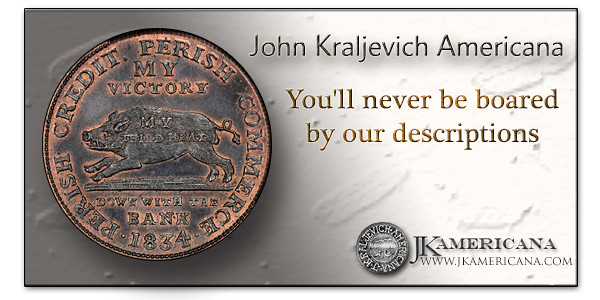
MORE ON U.S. CIVIL WAR STORE CARDS, 3RD EDITION
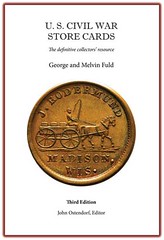
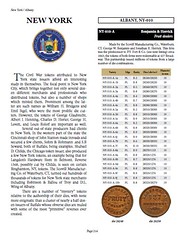
The book is 664 pages in full color. Includes many merchant biographies, historical insight and guides on how to collect. Price is $85.00 to members of The Civil War Token Society, $100.00 to non-members. Books can be ordered on line at www.CWTsociety.com or from Rick Snow at Eagle Eye Rare Coins. P.O. Box 32891 Tucson AZ. 85751 email Karin@indiancent.com.
To read the earlier E-Sylum article, see:
NEW BOOK: U.S. CIVIL WAR STORE CARDS, 3RD EDITION
(www.coinbooks.org/esylum_v17n48a03.html)
BOOK REVIEW: PLEASURE & PROFIT
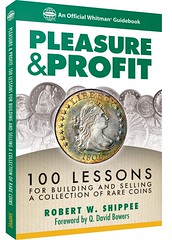 Pleasure & Profit: 100 Lessons For Building and Selling A Collection of Rare Coins, is the latest entry in Whitman's Guidebook series.
The book is by first time author Robert Shippee a retired international banker. The book tells the story of Mr. Shippee putting together a first
class type set consisting of consisting of 137 PCGS graded coins. The cost of the collection was slightly over $1 million, and the collection was
sold at auction approximately 8 years after it was started for about $1.4 million, netting a nice profit, not including the pleasure of ownership Mr.
Shippee had.
Pleasure & Profit: 100 Lessons For Building and Selling A Collection of Rare Coins, is the latest entry in Whitman's Guidebook series.
The book is by first time author Robert Shippee a retired international banker. The book tells the story of Mr. Shippee putting together a first
class type set consisting of consisting of 137 PCGS graded coins. The cost of the collection was slightly over $1 million, and the collection was
sold at auction approximately 8 years after it was started for about $1.4 million, netting a nice profit, not including the pleasure of ownership Mr.
Shippee had.
Mr. Shippee offers numerous lessons regarding both purchasing and selling coins. Most people (I would estimate 95% of collectors) have nowhere near this sum to spend on their hobby, yet the lessons can be applied to lower expenditure. Mr. Shippee advises to buy coins that are nice looking for the grade and to avoid problem pieces. This advice can easily be applied to someone working on Very Fine set of Barber Half Dollars for instance, even though such a set while very challenging (it will take years) would be in the $15 thousand range. We are advised to hold coins for a long period of time, which makes sense as explained that unlike stocks, there is a large cost of 15%- 25% in buying and selling a coin.
Additional good advice that can be applied to all levels of the hobby is to do your research before you buy, and to look at as many coins as you can to learn what a natural "no problem" coin looks like. If you purchase desirable "no problem" coins, you will likely have many buyers interested in your coins when it comes time to sell.
Even with all of Mr. Shippee's study and diligence, he still managed to lose money on certain very nice coins, which he attributes in many cases to being over exuberant at auctions, so take his advice, and go slow, even the best coin will be a mistake if you overpay. The author's other passion is golf, and he gives numerous golf analogies throughout the book. I don't think he mentions that 5 hours after a round of golf, you have lost 100% of your financial investment (the $100-$200 cost of the round). I guess coin collecting falls somewhere between the stock market (all gain or loss, no pleasure) and golf (100% financial loss, all pleasure). All in all a very enjoyable clearly written book, which gives good advice to collectors at all levels.
To read the earlier E-Sylum article, see:
NEW BOOK: PLEASURE AND PROFIT (www.coinbooks.org/esylum_v17n40a04.html)
THE UPCOMING BOOK PROJECTS OF Q. DAVID BOWERS
On Thursday Dave Bowers wrote:
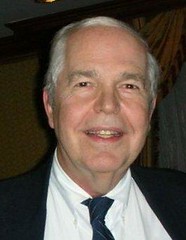 What I have been
doing in recent times and will continue to do is consolidating a lot of my research, draft notes, semi-manuscripts, and the like and finalizing them
in book form, mainly through Whitman LLC.
What I have been
doing in recent times and will continue to do is consolidating a lot of my research, draft notes, semi-manuscripts, and the like and finalizing them
in book form, mainly through Whitman LLC.
Someday I will finesse my autobiography (to date, although I expect to live a lot longer). Starting in the mid-1950s and continuing ever since I have done a lot of interviews in depth with people who are now gone—B. Max Mehl, Stephen K. Nagy, Arthur Conn, Art Kagin, JJF, Louis E. Eliasberg, Hans Schulman, Abner Kreisberg, Abe Kosoff, Michael Kolman, Jr., Walter Breen, Grover Criswell, Oscar Schilke, Ted Naftzger (who had four 1933 $20 coins), Dr. Sheldon, Dorothy I. Paschal, Lee F. Hewitt, J. Oliver Amos, Lewis M. Reagan, Henri Ripstra, Emery May Holden Norweb, and many more, plus many more who are now living. While I love coins I also like “coin people” and have found them endlessly interesting.
Today in 2014, despite the “mechanical” nature of coin trading, I think there are more talented researchers and writers than ever before in our hobby (I still don’t think the art and science of numismatics is an industry, any more than fine art is). Today is Thanksgiving, and I am very thankful for many things—including being in numismatics since 1952.
PETER PRESTON-MORLEY RECALLS DAVID LITRENTA
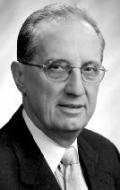 I was saddened
to learn in the latest E-Sylum of the death of David Litrenta. David was a well-known name in coin collecting circles on both sides of the
Atlantic and myself, along with Richard Gladdle and other worthies in the Conder token-collecting fraternity here in the UK, enjoyed legendary
hospitality with him, in York and in Shrewsbury, over many years. The first time I visited him, having driven up to York straight off the plane from
Dulles, he engineered an excuse to take me to visit to the local coin dealer's shop in town (whose name I regret I've forgotten) which
started at 9PM and ended at 4.30AM…
I was saddened
to learn in the latest E-Sylum of the death of David Litrenta. David was a well-known name in coin collecting circles on both sides of the
Atlantic and myself, along with Richard Gladdle and other worthies in the Conder token-collecting fraternity here in the UK, enjoyed legendary
hospitality with him, in York and in Shrewsbury, over many years. The first time I visited him, having driven up to York straight off the plane from
Dulles, he engineered an excuse to take me to visit to the local coin dealer's shop in town (whose name I regret I've forgotten) which
started at 9PM and ended at 4.30AM…
David was a life-long collector, starting in Baltimore with gifts from his grandfather, whose career in the railway industry took him around the world and who picked up unusual pieces. Out of this source of numismatic curiosities came the inspiration that would last a lifetime, fuel many hours of devoted research and result in a multi-million dollar collection.
While the collecting ‘bug’ never quite left him, David had to put it on hold on several occasions; medical school, building a medical practice and raising seven children with his wife Shirley all took a toll on his numismatic activity. In time, his success in preventative and occupational medicine provided him with the means to pursue rare coins more vigorously. With help from some of the principal dealers and auction houses in the USA, he began to seriously collect the coins of his native country in the early 1980s, amassing many of the classic rarities. His US and ancient coins, and his collection of George Washington-related medals and memorabilia were auctioned, as Fred Lake says, by Heritage in five sales in 1999 and 2000.
David first turned his attention to British trade tokens, especially the 18th century Conder series, in the mid-1990s. He amassed a holding of over 1,700 pieces, almost all of unusually high overall quality – hardly surprising bearing in mind that one of David’s personal numismatic mantras was ‘to acquire the most beautiful coins you can afford; quality not quantity counts.’ His collection was auctioned by DNW in four sales in London in 2005-6.
He kept his coin and token books, of course, and some of those have appeared on the market since.
To read the earlier E-Sylum article, see:
DAVID E. LITRENTA 1936 - 2014 (www.coinbooks.org/esylum_v17n48a06.html)
THE BOOK BAZARRE
U.S. MINT DIRECTOR GEORGE N. ECKERT
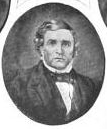 Regarding Rachel Street's request for an image of U.S. Mint Director George N. Eckert, Dave Ginsburg
writes:
Regarding Rachel Street's request for an image of U.S. Mint Director George N. Eckert, Dave Ginsburg
writes:
Evans’ Illustrated History of the Mint has an image of George Eckert. Here’s a link to an edition on Google Books. The image is on page 100 of the 1893 edition.
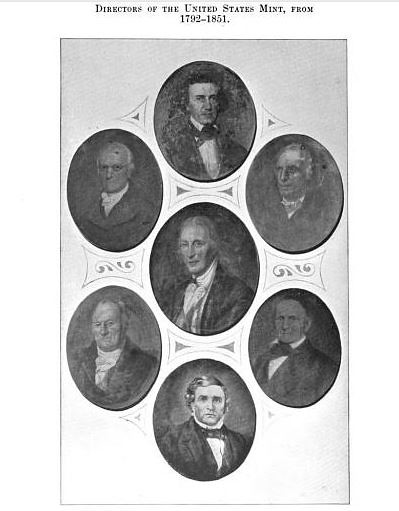
To read the book on Google Books, see:
Illustrated history of the United States mint
(books.google.com/books?id=Wz4KAQAAMAAJ)
Rachael Street writes:
Thanks, I appreciate it! We’ve also received a response from Bob Julian—the numismatic grapevine sure works quickly!
To read the earlier E-Sylum article, see:
QUERY: IMAGE OF MINT DIRECTOR ECKERT SOUGHT
(www.coinbooks.org/esylum_v17n48a09.html)
NOTES FROM E-SYLUM READERS: NOVEMBER 30, 2014
Coins and Coin Books Don’t Have To Be Stuffy Subjects
Jeff Kelley writes:
I almost missed hearing about the display in London save for a sidebar story on an Internet news web site, and I almost did not click on it. Had I not, then The E-Sylum would have been my first notice of it. That is a sad commentary in terms of the U.S. media’s failure to more widely report this, but a great compliment to the E-Sylum. That is one of the things that makes The E-Sylum such an important read – it informs and inspires readers on a variety of subjects that may emanate from a numismatic connection; coins and coin books don’t have to be stuffy subjects – they can open up the world in limitless ways. I try to stay informed about both current events and interesting bits of history by regularly visiting a small handful of websites, and www.coinbooks.org (Tthe E-Sylum) is as important a stop as any of them.
To read the earlier E-Sylum article, see:
THE ROYAL MINT'S 2014 REMEMBRANCE DAY COIN
(www.coinbooks.org/esylum_v17n47a19.html)
Notes from Larry Gaye: Operation Bernhard, Junk Keying
Larry Gaye writes:
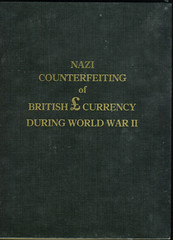 Very nice issue Wayne, I enjoyed it muchly. Good to see the 1987 book Nazi Counterfeiting of
British Currency During World War II: Operation Andrew and Operation Bernhard get some notice. I was fortunate enough to purchase the book when
it was first published. I had recently acquired two Bernhard notes, a five and a fifty, along with a Bank of England fiver. The book certainly helped
me decipher which was which.
Very nice issue Wayne, I enjoyed it muchly. Good to see the 1987 book Nazi Counterfeiting of
British Currency During World War II: Operation Andrew and Operation Bernhard get some notice. I was fortunate enough to purchase the book when
it was first published. I had recently acquired two Bernhard notes, a five and a fifty, along with a Bank of England fiver. The book certainly helped
me decipher which was which.
It's an excellent book, short, but concise; a must for any currency collector's library. My feeling is the book would be a steal at $125.00.
The piece regarding the Keying medal's was also fun. I came across one a couple of years back and held it for a bit to "Hug It, and Love IT, and Call it George." I had a lot of fun researching it when I first received it. It went on to another collector after my enjoyment was fulfilled.
Thanks so much for your efforts, as the Brits would say, Brilliant!
To read the earlier E-Sylum articles, see:
NUMISMATIC LITERATURE IN ROSENBLUM SALE #44B (www.coinbooks.org/esylum_v17n48a02.html)
MORE COMMEMORATIVE MEDAL SELECTIONS FROM BALDWIN'S
(www.coinbooks.org/esylum_v17n48a15.html)
Numismatic Terminology: Dentil vs Denticle
Dennis Tucker of Whitman Publishing writes:
This is an esoteric point, but one that might be of interest to readers of The E-Sylum, auction catalogers, and numismatic writers.
On dentil vs. denticle: Most dictionaries specifically define a dentil as being square or rectangular, and a denticle as being tooth-like. Since these coin-rim projections often are rounded or spiked (as opposed to rectangular or square) but always are tooth-like, Whitman’s editorial house style is to use the word denticle.
Dennis adds:
P.S. Contrary to urban legend, we do not have a board-certified dentist on staff to monitor this usage.
NOTES FROM PAUL BOSCO ON NORTON, CHAMBERLIN AND PLATE MONEY
The Ladies in Waiting of Emperor Norton's Court
Regarding Neil Shafer's question about the 1953 Emperor Norton Gold Crown notes, Paul Bosco writes:
In my November 2000 auction, which was primarily U.S. Exonumia, there was a gold medal for the Ladies in Waiting of Emperor Norton's Court. I believe it was from 1953 and issued by the SF Chronicle.
To read the earlier E-Sylum article, see:
QUERY: 1953 EMPEROR NORTON GOLD CROWN NOTES
(www.coinbooks.org/esylum_v17n48a23.html)
Neville Chamberlain Medals Relating to Winston Churchill medals, Paul adds:
There is now a book on Neville Chamberlain, particularly interested in images of him and the politics/statecraft of his time, by Max Everest-Phillips. Medals are included.
To read the earlier E-Sylum article, see:
CHURCHILL AND SCULPTOR OSCAR NEMON (www.coinbooks.org/esylum_v17n48a07.html)
Swedish Plate Money
On Swedish Plate Money, Paul writes:
 I see
Stack's-Bowers has a collection of Swedish Plate Money coming up. Those who are seriously interested in these odd & curious "coins"
should be aware of the NASCA auction of December 1980, which featured a few dozen, including a 26-pound 8-Daler (it made just over $1000 per pound).
Obviously, the sale did not have any water-damaged pieces, as it preceded the recovery of the Nicobar plate money.
I see
Stack's-Bowers has a collection of Swedish Plate Money coming up. Those who are seriously interested in these odd & curious "coins"
should be aware of the NASCA auction of December 1980, which featured a few dozen, including a 26-pound 8-Daler (it made just over $1000 per pound).
Obviously, the sale did not have any water-damaged pieces, as it preceded the recovery of the Nicobar plate money.
Calling this a "Stack's-Bowers" offering is something of a misnomer, as it is very much a sale by their World Coins subsidiary, Ponterio. Rick P and his sons will be sure to present the collection in a manner that preserves a numismatic record.
To read the earlier E-Sylum article, see:
STACK'S BOWERS: THE STANLEY ABERDEEN COLLECTION
(www.coinbooks.org/esylum_v17n48a18.html)
ON PERSPECTIVE IN MEDAL DESIGN
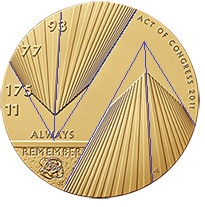 Although the New York 0/11 medal is a striking design, the faulted perspective isn't properly executed--the artist took quite a liberty here. (I
am sure it was deliberate; proper perspective has been understood since the Renaissance.) No matter what type of perspective is employed, all of a
group of parallel lines need to converge on one point, called the vanishing point. The towers being vertical lines, their vertical lines are parallel
and should converge. Yet on the medal, the left tower's vertical lines converge lower left, while the tower on the right, whose vertical lines
should be parallel to the other tower's lines, instead has its lines converging towards the upper right.
Although the New York 0/11 medal is a striking design, the faulted perspective isn't properly executed--the artist took quite a liberty here. (I
am sure it was deliberate; proper perspective has been understood since the Renaissance.) No matter what type of perspective is employed, all of a
group of parallel lines need to converge on one point, called the vanishing point. The towers being vertical lines, their vertical lines are parallel
and should converge. Yet on the medal, the left tower's vertical lines converge lower left, while the tower on the right, whose vertical lines
should be parallel to the other tower's lines, instead has its lines converging towards the upper right.
Here are a couple of photographs to show how it works in reality. The first is taken from between a pair of skyscrapers, though they aren't the WTC:

(Note that the lines don't even have to be drawn off the corners of the building--ANY vertical line, even those between columns of windows, will converge to the same point because it's parallel to every other vertical line.)
And here's the actual WTC, though not taken from a point between the towers.
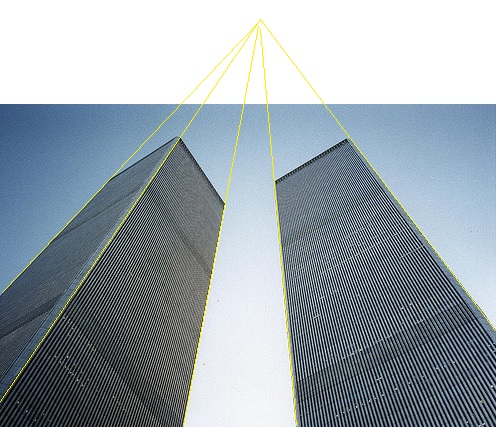
In this case the point of convergence or vanishing point is outside the photo (the fact that the yellow lines don't quite meet is symptomatic only of my imperfect vision and clumsiness with the mouse).
Whatever one may think of the merits of the medal design, one thing it surely isn't is an example of vaulted perspective, because it's not even remotely properly done. I'm sure the artist did this deliberately, because it's simply too glaring to be a mistake. While I heartily endorse the desire to memorialize what was destroyed on that awful day (I did buy one of the medals myself) I found the incorrect perspective very distracting. It suggests to me the towers caught in the act of toppling almost toward each other (even though they didn't).
Which, come to think of it, could be exactly the impression the artist was trying to make.
On a related note, Dave Lange writes:
In reading Dick Johnson's comments about the Fallen Heroes Medal, he commented that it depicts the new towers rising. It appears to me, however, that it actually depicts the old Towers 1 and 2 that were lost on 9-11.
To read the earlier E-Sylum article, see:
FALLEN HEROES MEDAL DESIGN: VAULTED PERSPECTIVE
(www.coinbooks.org/esylum_v17n48a13.html)

ELIASBERG'S 1873-CC DIME
First to respond was Pete Smith, who writes:
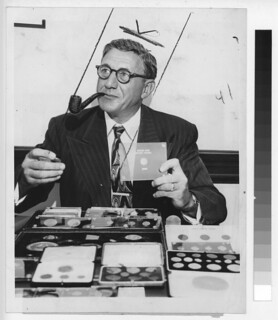 What coin is
Eliasberg holding in the photo shown in The E-Sylum? My guess is that it is his 1873 CC Dime. I wanted to answer quickly in an attempt to be
the first to answer. Give me a little time and I will give you a listing of newspapers where the photo appears.
What coin is
Eliasberg holding in the photo shown in The E-Sylum? My guess is that it is his 1873 CC Dime. I wanted to answer quickly in an attempt to be
the first to answer. Give me a little time and I will give you a listing of newspapers where the photo appears.
Len Augsburger writes:
I honestly don't know the answer to the question. This image came out of the newspaper morgue & I don't have the caption.
Pete Smith writes:
I am attaching a clipping from the Corpus Christi CALLER-TIMES of Sunday, September 28, 1952. The story was picked up by many papers and I suspect there may be other copies of the picture out there.

To read the earlier E-Sylum article, see:
QUIZ: IDENTIFY LOUIS ELIASBERG'S COIN (www.coinbooks.org/esylum_v17n48a12.html)
IS 1876 PRIZE COUNTERSTAMP OF BRITISH ORIGIN?
Regarding Dave Schenkman's counterstamped 5-Centimes, Paul Bosco writes:
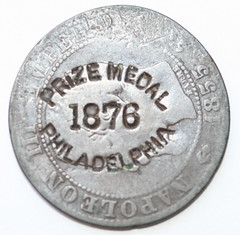 This looks to
me unsuspiciously like one of many European coppers that circulated in England in 1876 and surrounding decades. Some famous (i.e. common) ones are
PEAR'S SOAP and BORWICK'S BAKING POWDER. Such British Isles counterstamps on copper and bronze coins, both merchant pieces and others, are
cataloged in a book by Gavin Scott.
This looks to
me unsuspiciously like one of many European coppers that circulated in England in 1876 and surrounding decades. Some famous (i.e. common) ones are
PEAR'S SOAP and BORWICK'S BAKING POWDER. Such British Isles counterstamps on copper and bronze coins, both merchant pieces and others, are
cataloged in a book by Gavin Scott.
It became illegal to deface British bronze coins. (Smaller coins in bronze replaced the earlier coppers, beginning 1860.) However, Continental "5" and "10" coins --Centimes, Centesimi, Stotinki, Para, etc.-- were issued by Latin Monetary Union countries. These circulated in England, where they were just about the same size as the Halfpenny and Penny bronze coins. Advertisers stamped them and put them into circulation.
This piece may relate to a British product that won an award at the Expo in Philly. At this time, I haven't been able to check if Scott lists it. It may be some kind of trial, never issued in an effective quantity for advertising. These kinds of pieces were not stamped on both sides, so this anonymous piece does not make sense. Nonetheless, it very much has the right look for inclusion in the series in question.
To read the earlier E-Sylum articles, see:
NUMMIS NOVA NUMISMATIC DIARY: NOVEMBER 16, 2014: Query: Two Unusual 1876 Centennial
Items (www.coinbooks.org/esylum_v17n47a23.html)
PAUL CUNNINGHAM ON TWO 1876 CENTENNIAL ITEMS
(www.coinbooks.org/esylum_v17n48a11.html)
MORE LUCITE-ENCASED COINS: SPELLMAN, BEISTLE
Cardinal Spellman's Lucite-Encased Fugio Cent
Tony Terranova writes:
Those Lucite-encased Fugio coppers were made for the Bank of New York for promo purposes. They were given to various people for big new deposits or bank employees for long term service, etc. I have one presented to Francis Cardinal Spellman of the diocese of NYC.... They sometimes come with their little, plush brown & gold paper boxes.
60th Anniversary of The Beistle Company
Dave Lange writes:
I have an addition the ongoing discussion of Lucite encased coins and medals. I purchased this item on eBay a couple years ago, when I was preparing my book on National Coin Albums, and it's illustrated within that book. This paperweight encases a 1960 Philadelphia Mint set and marks that year's 60th Anniversary of The Beistle Company, the maker of all Wayte Raymond coin holder products. I have absolutely no desire to free the coins, as the value lies in the rare souvenir; it is the only example I've seen in many years of collecting all things coin album.
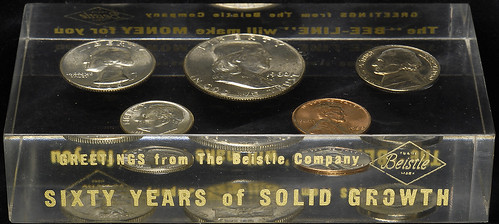
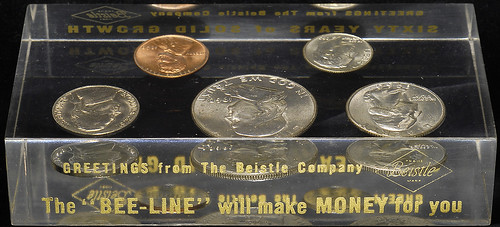
To read the earlier E-Sylum article, see:
BANK OF NEW YORK FUGIO CENT IN LUCITE (www.coinbooks.org/esylum_v17n48a26.html)
STACKS BOWERS OFFERS GOLD LINCOLN MEDAL AND MEDALET SET
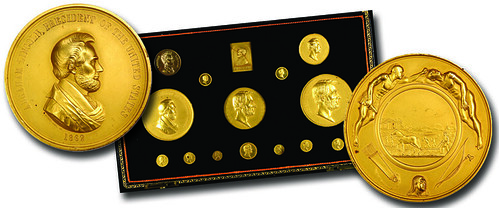
An amazing – not many other superlatives fit – 15-piece boxed “set” of Lincoln medals and medalets, all in gold, will be a focal point in our upcoming February 2015 New York City Americana Sale. Originally sold by us in September-October 2010 as individual lots in our Philadelphia Americana Sale, this set was owned at various times by Judson Brenner, Henry Chapman, T. James Clarke, and the Stack family. Then it went on to become part of the famous Eliasberg Collection, where it remained from 1945 until our sale of the group in 2010.
This incredible grouping of gold Lincolniana represents one of the most important opportunities ever offered to collectors who favor the many exonumia tributes paid to Lincoln over the years. Far and away the most important of the 15 medals is the unique gold Indian Peace medal, Julian IP-38, struck some time after Lincoln’s death by the Mint for an unknown collector of the era. Its weight of 7.58675 troy ounces alone is enough to turn heads, and its unique stature speaks volumes on its rarity.
Other pieces in the set include a Lincoln Presidential medal by George T. Morgan, Julian PR-12 (7.317 troy ounces); 1871 Emancipation Proclamation medal, Julian CM-16 (1.76 troy ounces); 1909 Lincoln medal by George T. Morgan, King-311; 1924 “Beloved Alike By Rich And Poor” medal by Thomas Elder, DeLorey-58; circa 1930s Lincoln plaquette by J. Henri Ripstra; 1868 Washington and Lincoln medalet, Julian PR-31; 1869 Lincoln Broken Column medalet, Julian PR-38; 1869 Lincoln and Grant medalet, Julian PR-39; 1882 Lincoln and Garfield medalet, Julian PR-40; 1882 Lincoln and Garfield medalet, Julian PR-41 (3 pieces); 1910 Lincoln token by Elder, DeLorey-47; and 1927 Lincoln token by Elder, DeLorey-48.
This group, perhaps the single most important “set” of its kind in the hands of Lincolniana collectors, will attract fans of Honest Abe and medal specialists alike. It is housed in a custom black leatherette box made in the mid 1940s especially for Louis E. Eliasberg, Sr. The offering of this set – perhaps your only opportunity to obtain it – will make headlines in February 2015 in New York City.
To read the complete article, see:
Amazing 15-Piece Gold Lincoln Medallic Set With Unique Gold Lincoln Indian Peace Medal A Major Highlight in Our February 2015 Americana Sale
(www.stacksbowers.com/NewsMedia/Blogs/TabId/780/ArtMID/
2678/ArticleID/64866/Amazing-15-Piece-Gold-Lincoln-Medallic-Set
-With-Unique-Gold-Lincoln-Indian-Peace-Medal-A-Major
-Highlight-in-Our-February-2015-Americana-Sale.aspx)
THE BOOK BAZARRE
U.S. MINT ENGRAVER ENGELHARDUS VON HEBEL
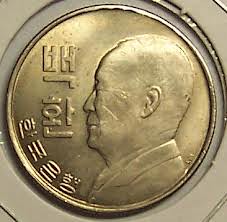
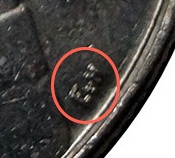
U.S. MINT ENGRAVER'S INITIALS IDENTIFIED.
An inquirer at CoinTalk earlier this year asked the identity of the initials EvH on a 100-hwan coin of South Korea. The coin was struck at the Philadelphia Mint but In nearly a year's time no one came forth with the correct answer.
Many comments were wild guesses. One stated correctly the artist must be German as the lower case "v" must have been for "von," that the artist must be German. Others speculated it was a friend of Seung-Man Rhee whose portrait is shown on the coin.
The answer is Engelhardus von Hebel.
And what do we know of this artist? Plenty! Here is some of the data from my databank on American artists, soon to be on the internet available to all without cost.
Engelhardus von Hebel was a staff engraver at the Philadelphia Mint from 1949 to 1961. Born in Germany February 15, 1892, he engraved some notable American medals in addition to that 100-hwan coin for South Korea.
As was the custom of the Philadelphia Mint at the time engravers did only one side. A new engraver is assigned the lesser important side until he proved himself, while the chief engraver or other senior engraver created the important portrait, usually the obverse.
In 1949 he engraved only the seal on the reverse of the Harry Truman Presidential Medal (List 132), while John R. Sinnock did the obverse, Gilroy Roberts did the rest of the reverse.
He passed the test. He was allowed to do the entire reverse of the Dwight D. Eisenhower Presidential Medal (List 134), while Gilroy Roberts did the portrait obverse. The same two engravers created the William Howard Brett Director of the Mint Medal of 1954 (List 317).
In 1955 Chief Engraver Roberts modeled a Winston Churchill Medal -- von Hebel did the reverse -- and the following year a Louis D. Brandis Medal, Roberts obverse, von Hebel reverse.
Von Hebel did four U.S. Assay Medals, always the reverse, while Frank Gasparro did two and Gilroy Roberts did two obverses. For two different 1960 and 1961 Pony Express Centennial medals again it was Gasparro obverse, von Hebel reverse. Same for the 1961 Mobile Alabama 350th Anniversary Medal.
Always the bride's maid, never the bride. Von Hebel finally was assigned the complete medal -- both obverse and reverse -- for the Robert Goddard Congressional Medal of 1959. He followed that with a second Congressional; Medal, this for Robert Frost in 1960.
In 1961 he resigned his engraving post at the mint and went to live with his daughter and her husband in La Jolla California. He died there at age 95 December 12, 1987. All this data will become available shortly as we wind up working on a web site, also to include numismatic citations of all coins and meals, medal auction sales, and published references. both biographic and numismatic. However, not all the 4,147 artists of American coins and medals covered in my databank will have this much data. Some will have more.
To read the complete discussion on CoinTalk, see:
US Mint Engraver(?) with the initials "EvH"
(www.cointalk.com/threads/us-mint-engraver-with-the-initials-evh.241728/)
ENOUGH WOODEN NICKELS TO FLOAT A BATTLESHIP
Bob Gabriel, President of the International Organization of Wooden Money Collectors (IOWMC) writes:
I'm a friend of the Honorable Bob Fritsch who enjoys your email newsletter. The attached typifies us wooden nickel collectors. Please consider it for a future issue.
 ELKTON, Md..
Walter and Mayme Scott don't buy the old maxim, "Don't take any wooden nickels." In fact, they'll take all the wooden nickels
they can get.
ELKTON, Md..
Walter and Mayme Scott don't buy the old maxim, "Don't take any wooden nickels." In fact, they'll take all the wooden nickels
they can get.
The Scotts - she's 60; he's 67 and a retired auto worker - own a small fortune in the bogus currency. Scott estimates that he has about 25,000 wooden nickels. They're kept in about 50 loose-leaf binders, each book bulging with 25 to 30 pages of coin-filled plastic pockets. There's enough, Scott jokingly guesses, "to float a battleship."
The Scotts, who live in this small town in northeastern Maryland's Cecil County, found their hobby doing another collector a favor. In 1974 a friend asked Scott to deliver the man's special wooden nickel collection to an exhibit in Shippensburg, Pa. Soon Scott had his own 273-piece collection commemorating the county's 300th anniversary.
Now the Scotts own buckets of wooden nickels issued by chain restaurants including McDonald's, Dairy Queen and Hardee's. Some were worth real money, such as the one that reads: "Good for 25 cents with next purchase at any White Coffee Pot Jr.," a Baltimore fast-food chain.
They own handfuls of Canadian spruce dollars - relatively rare oversized wooden nickels made from spruce trees that fetch $5 and more on the collectors' market. Their riches also include wooden nickels from the now-defunct Sambo's restaurant chain, which mulched nickels left over when it went out of business. Collectors have paid up to $18 for those hard-to-find Sambo's nickels.
The Scotts, who also collect wooden Christmas cards and wooden postcards, say their collection is virtually worthless. But they add that a wooden nickel without monetary value printed on it isn't worth, well, let’s say “a wooden nickel”.
"It has to have a monetary value (printed on it) or it's not a wooden nickel," Scott said. "It's a wooden token." And they know their wood coinage. Both Scotts are past presidents of the International Organization of Wooden Money Collectors (IOWMC), founded in 1964. Walter was the 18th president in 1982 and Mayme was the 23rd president in 1988. Scott is also in his 10th year as editor of the club's official newsletter, Bunyan's Chips. The newsletter is mailed to about 350 of the club's 375 members, Scott said, including two in Puerto Rico and a couple of servicemen in Germany. Based on the fluctuating membership, Scott estimates that at least 2,000 people in America collect wooden nickels.
"We (collect), because it's a hobby," said Mayme Scott. "We just like doing it. We like the friendships we make."
According to the Macmillan Encyclopedic Dictionary of Numismatics, the first wooden money in America was ersatz dollars made for the unlucky depositors of the Citizens Bank of Tenino, WA, when the bank failed in the 1930s. Customers were supposed to use the wooden money as cash.
Noting that wood imitations of paper money were made in Austria in 1920, and that Canada and other countries have occasionally struck wooden currency, the dictionary defined wood money as still "considered distinctly an American contribution to exonumia" - objects that resemble money but are not legal tender.
Albert Bonesio, 72, of Torrington, Conn., first vice president of the International Organization of Wooden Money Collectors, has collected wooden nickels for 30 years. He's also president of a spinoff wooden money club, Dedicated Wooden Money Collectors (DWMC).
A collection's value just depends, Scott said. "What do you want to pay for it? What's it worth to you? That's the bottom line. It’s not unlike any other collection, coins included, what’s it worth to you?"
Bob adds:
Walter A Scott was born 12/20/1925 and died 4/14/1999 in Elkton, MD. ; Mayme E was born 8/5/1932 and died 3/22/2004 also in Elkton, MD.
Albert Bonesio was also a IOWMC president in 1995-1996. He was born 6/9/1921 and died 1/20/1997 in Torrington, CT.
COMMEMORATIVE COIN FOR NORTH BAY SHOE STORE
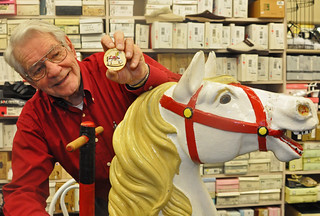 Deegan’s Shoes,
one of the mainstays of North Bay’s downtown, has issued a commemorative coin to celebrate the store’s 125th anniversary of its historic
business.
Deegan’s Shoes,
one of the mainstays of North Bay’s downtown, has issued a commemorative coin to celebrate the store’s 125th anniversary of its historic
business.
“Being that it’s the 125th anniversary of our store, we thought it was quite appropriate to create a souvenir coin that has a mintage of only 125 pieces”, says Ralph Diegel, owner of Deegan’s Shoes on Mainstreet. “Pat and I (Ralph’s wife) are quite excited that the coins have come in just on time for the annual downtown Christmas walk this Friday (November 28th). We’ll be selling the coins then (at $25 each). Come in early, though, because 125 pieces won’t last long” added Ralph.
The 50 millimetre coin is indeed impressive. One side features the iconic rocking horse, enjoyed by so many customers who came into the store over the years. The other side shows the building which housed the original Deegan’s store until it was destroyed by fire in January of 1945. It was rebuilt in the same location soon after and now, 125 years later, the business is still going strong.
“It’s hard to believe that it’s been 125 years”, says Ralph, who himself has been working at the store for nearly 70 years. “I ended up here by accident really”, he adds. “I was originally supposed to work at the store over the pre-Christmas rush in 1946 and never ended up leaving.”
Deegan’s will be part of the old fashioned Christmas Walk this Friday and will open their doors to new and old customers alike, or to anyone who just wants to enjoy the friendly staff at the store along with a warm beverage and snacks and of course, one of the souvenir coins. It is believed that this is the only souvenir coin ever issued in North Bay specifically for a downtown store.
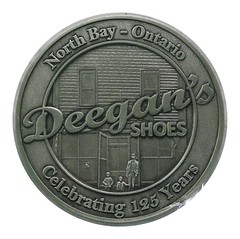
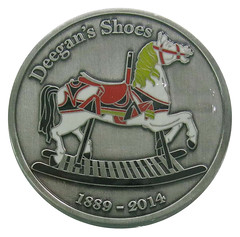
To read the complete article, see:
City's oldest business celebrates by issuing coin
(www.baytoday.ca/content/news/details.asp?c=69730)
SOME INTERESTING MEDALS: NOVEMBER 30, 2014
National Medal of Science
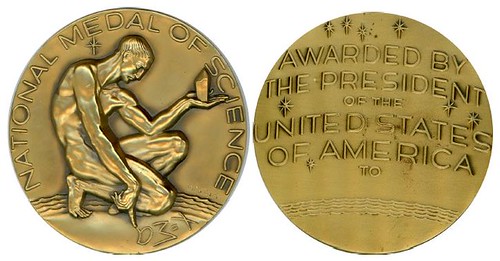
NATIONAL MEDAL OF SCIENCE. Alexander 9. 82.6mm. Bronze. Donald De Lue, Sc. Edge marked: © 1990 MEDALLIC ART CO. -DANBURY, CT.- BRONZE. Choice Uncirculated.. Obverse with NATIONAL MEDAL OF SCIENCE around a kneeling man holding aloft a crystal and scratching a formula into the earth. The reverse is inscribed: AWARDED BY/ THE PRESIDENT/ OF THE/ UNITED STATES/ OF AMERICA/ TO/ ((blank).
The National Medal of Science is the Nation's highest scientific honor bestowed by the President of the United States. The main criteria considered for selection is the total impact of an individual's work on the present state of physical, biological, mathematical, engineering, behavioral, or social sciences. In addition, achievements of an unusually significant nature are considered and judged in relation to the potential effects of such achievements on the development of scientific thought. Also, consideration is given to distinguished service in the general advancement of science and engineering when accompanied by substantial contributions to the content of science at some time. It was first awarded in 1962 and is still awarded today.
Recipients of the medal receive a 19mm 14k gold lapel pin and an inscribed 82mm bronze medal. Uninscribed medals, such as this, are presumably samples. $995.00
Yorktown Sesquicentennial Medal

YORKTOWN SESQUICENTENNIAL, 1931. Baker K-454 68mm. Bronze. Pierre Turin, Sc. (Paris Mint – edge marked with cornucopia, BRONZE). About Uncirculated. Obv: Conjoined busts to the right of Washington, De Grasse-Tilly & Rochambeau and Roman numeral dates for 1781 - 1931. Rx: Map of battle scene. CAPITULATION/ DE/ YORKTOWN above. $85.00
National Association of Manufacturers Statue of Liberty Medal

NATIONAL ASSOCIATION OF MANUFACTURERS STATUE OF LIBERTY MEDAL, 1940. Gabriel GX-40; Marqusee 108. 76.7mm. Bronze. Rene Chambellan, Sc. (MACO) Choice About Uncirculated; a few minor spots.
Obverse with a dominant figure of the Statue of Liberty at center. Surrounding it are views of the U.S. Capitol, Federal and Faneuil Halls, a skyscraper and smoking factory. At bottom a speaker addresses a crowd and to the right a screw press and a large toothed gear.
The reverse bears a large flaming caldron supported by a gigantic tripod, the arms of which are inscribed: FREE PRIVATE ENTERPRISE/ CIVIL AND RELIGIOUS LIBERTY/ REPRESENTITIVE DEMOCRACY. Running around the right side is the legend: THE NATIONAL ASSOCIATION OF MANUFACTURERS. At the base of the tripod is a farmer; an industrial worker and a family with a steepled church in the background. The medal was distributed to members of the NAM’s Congress of American Industry in 1940. $195.00

NATIVE AMERICAN $1 COIN LASER TREATMENTS
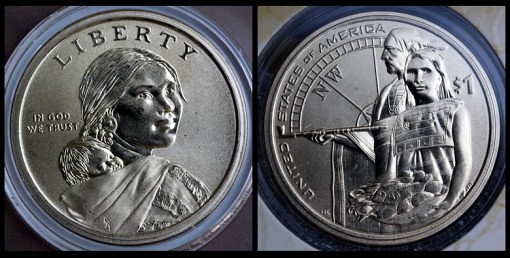
Another key coin from the United States Mint this year is the 2014-D Enhanced Uncirculated Native American $1 Coin within the 2014 American $1 Coin and Currency Set.
Priced at $13.95, some collectors commented early that the set was inexpensive yet overpriced since the face value of its contents added up to just $2. But then it wasn’t clear then that the set held a $1 coin with a unique finish and that it also hadn’t been released elsewhere. Now that price seems like a bargain.
Here’s a color-coded graphic showing areas of the coin that received unique treatments:
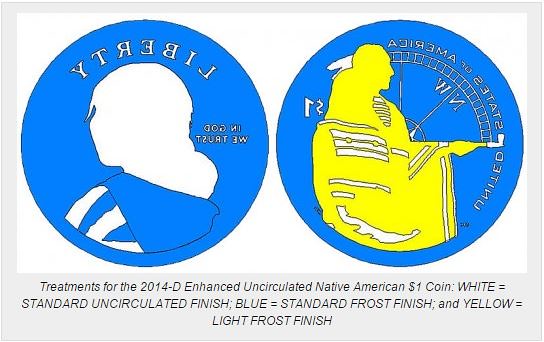
A wire brush (bright) finish has been applied to both obverse and reverse fields and artwork on the dies. The obverse and reverse artwork was then frosted, according to the color key below:
- White represents areas with a standard uncirculated finish,
- Blue shows regions of standard laser frosting, and
- Yellow indicates areas of light laser frosting
The enhanced uncirculated finish is VERY noticeable with the coin in hand — especially the reverse. You don’t need a loupe to best see the effects like on the 2014-S Enhanced Uncirculated Kennedy Half-Dollar (see its treatments) from the four-piece 2014 50th Anniversary Kennedy Half-Dollar Silver Coin Collection. Here are some additional U.S. Mint-provided details about the enhanced uncirculated dollar:
Being an Enhanced Uncirculated program, the base finish on the obverse & reverse was wire brushed. This was developed specifically for this program and implemented into production for the first time. This approach gives the coins a bright finish without appearing polished (like proof coins do).
On the obverse, standard laser frosting was applied to the field and particular elements of the artwork to accentuate the design. Specific elements of the artwork and all lettering are in the wire brush finish to further accentuate them against the laser frosted field.
On the reverse, standard laser frosting was applied to the field. A lighter level of laser frosting was then applied to particular elements of the artwork to enable it to stand out. Specific elements of the artwork, all lettering and the compass are in the wire brush finish to further accentuate the design.
To read the complete article, see:
2014-D Enhanced Uncirculated
Native American $1 Coin Laser Treatments (www.coinnews.net/2014/11/26/2014-d-enhanced-uncirculated-native-american-1-coin-laser-treatments/)
QUERY: GREAT SEAL OF MASSACHUSETTS ON A SPOON

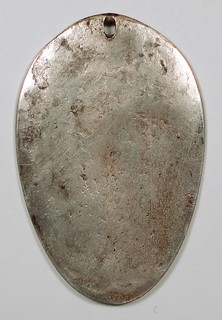
I picked this up because it was weird and I’d never seen anything like it before. I wonder if this rings any bells with E-Sylum readers?
This appears to be a flattened silver spoon. It is 36.4 x 55.5 mm at the widest points, 0.7 mm thick at the base and 1.5 mm thick at the top, 16.9 grams. It has cut marks at the top where the handle to the spoon would have been removed, and it gives a fantastic clear-as-a-bell ring test, suggesting that it’s silver.
I’ve lived in Massachusetts my whole life so I recognized that it was something related to the state seal. I didn’t realize until I looked it up that the seal has changed several times over the years. The state has a good page about the history of the state seal. This is in fact the earliest version of the Massachusetts State Seal, last used in an official capacity in 1692.
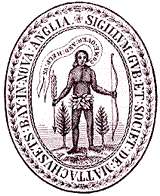
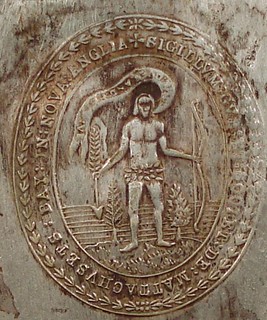
Making things more interesting — or perhaps simply more confusing — this object seems to have actually been _used_. There is significant wear within the crude hole at the top of the piece, and wear on the face as well. The full text on the ribbon would have read COME OVER AND HELP VS. — you can see the AND most clearly, upside down in the low point in the middle of the ribbon.
Also, it seems that the spoon was already flattened when the seal design was struck onto it. I don’t see any distortion on the seal that would have come from flattening, or any damage beyond normal wear.
All told, this feels like something that was made intentionally, and has a story behind it. I wish I knew what!
So the questions to E-Sylum readers are twofold: (1) Do you know anything about this item in particular, and (2) in the spirit of weird stuff, what or there sorts of objects have you seen flattened and repurposed as intentional striking media?
For more information on the Great Seal of Massachusetts, see:
The History of the Arms and Great Seal of the Commonwealth of Massachusetts
(www.sec.state.ma.us/pre/presea/sealhis.htm)
JAMES WATSON'S 1962 GOLD NOBEL PRIZE MEDAL
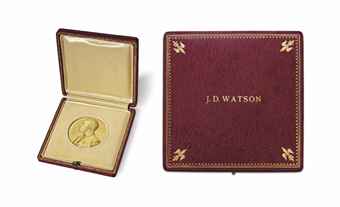
[WATSON, James Dewey]. Nobel Prize Medal in Medicine or Physiology for his work on the discovery of DNA’s structure. 23 carat gold, 66 mm diameter (approx. 2 5/8 in.). Profile bust of Alfred Nobel facing left on obverse, with “ALFR. NOBEL” at left and his dates in Roman numerals at right, signed along lower left edge (incuse) “E. LINDBERG 1902”, reverse with allegorical vignette showing the figure of Science unveiling Nature, signed at right “E. LINDBERG”, legend “INVENTAS VITAM IUVAT EX COLUISSE PER ARTES” around edge, “J. D. WATSON / MCMLXII” engraved below on plaque, with caption “REG UNIVERSITAS – MED CHIR CAROL” on either side of the plaque; rim marked “GULD 1950” (Kungliga Mynt och Justeringsverket [Swedish Royal Mint]); housed in original red morocco gilt case, interior lined in tan suede and satin.
Prior to 1980 the Nobel Prize medal was made from 23 carat gold, but since then Nobel Prize medals are made of 18 carat green gold plated with 24 carat gold. The diameter of the Nobel Prize medal is 66 mm but the weight and thickness varies with the price of gold. The average Nobel Prize medal is 175 g with a thickness ranging from 2.4-5.2 mm. Both sides of most of the categories of Nobel medals are the same, showing the image of Alfred Nobel and the years of his birth and death. However, the verso of the Physiology or Medicine medal is different (as here), depicting the goddess of medicine quenching the thirst of a sick girl. The medals for Physics, Chemistry, Physiology or Medicine and Literature were modeled by the Swedish sculptor and engraver Erik Lindberg (1873-1966).
In 1962, the Nobel Prize in Physiology or Medicine was awarded jointly to Francis Harry Compton Crick, James Dewey Watson and Maurice Hugh Frederick Wilkins “for their discoveries concerning the molecular structure of nucleic acids and its significance for information transfer in living material.” Maurice Wilkins’s colleague Rosalind Franklin (1920–1958), whose data and research using X-ray diffraction images of DNA were essential to Crick and Watson’s determining its structure and formulating their double-helical model, died of cancer at the age of 37, and was therefore not so honored because the Nobel Prize cannot be shared by more than three scientists, nor can it be awarded posthumously.
To read the complete lot description, see:
[WATSON, JAMES DEWEY].
NOBEL PRIZE MEDAL IN MEDICINE OR PHYSIOLOGY
(www.christies.com/lotfinder/books-manuscripts/watson-james-dewey-nobel-prize-medal-in-5857953-details.aspx)
To read the earlier E-Sylum articles, see:
FRANCIS CRICK'S 1962 GOLD NOBEL PRIZE MEDAL TO BE AUCTIONED
(www.coinbooks.org/esylum_v16n09a34.html)
MORE ON NOBEL PRIZE MEDALS (www.coinbooks.org/esylum_v16n10a10.html)
WHAT'S A GOLD NOBEL PRIZE MEDAL WORTH? (www.coinbooks.org/esylum_v16n16a12.html)
THE BOOK BAZARRE
AUCTION HOUSES ACCUSED OF "SUPPORTING TERRORISM"
 A cultural property battle is raging in Germany, and one archaeologist is attacking auction
firms and the antiquities trade in general, saying their efforts help finance terrorists.
A cultural property battle is raging in Germany, and one archaeologist is attacking auction
firms and the antiquities trade in general, saying their efforts help finance terrorists.
Auction houses and art dealers are fighting back, though. They say that the issue is grossly inflated, and that such businesses work to ensure proper title and origin of all items they sell.
The row began Oct. 20, when German broadcasting company Das Erste (ARD) aired a 43-minute video whose title translates to “The Squandered Legacy: Terrorist Financing by German Auction Houses.” A related story in English was also posted.
The same day, broadcaster DW (Deutsche Welle) aired a video interview with Michael Müller-Karpe of the Römisch-Germanisches Zentralmuseum (Roman-Germanic Central Museum) in Mainz. In the DW video, Müller-Karpe is quoted as saying: “The trade in antiquities promotes the destruction of archaeological sites and the information they contain, and it finances terrorism. One needs to be very clear: this market is soaked in blood.”
Qassam Atta, a spokesperson for the Iraqi military, is quoted in the DW video as saying, “One of the ways the Islamic State raises money is through the sale of Iraqi antiquities that are between 2[000] and 3,000 years old. For example, valuable ancient artifacts stolen from Mosul have been sold for large sums of money. These funds almost certainly go to financing the IS.”
In a statement from Gorny & Mosch released Nov. 13, the auction firm rejects the accusations made against it in the video.
“We are dismayed to see that a broadcast that is based on such poor and biased a research was to be watched on a broadcaster under public law and that its unsubstantiated assertions have made their way into the [television] news magazine ‘Tagesthemen’ as well,” according to a statement from the firm. “Deliberate false statements and manipulative collages of interviews, case studies that are taken out of context and are out of date, partial witnesses and allegations without evidence make for a mixture that we deem a justiciable defamation of the legal trade in ancient objects.”
Gorny & Mosch singled out the “wrong and fallacious” statements of Müller-Karpe, claiming that the video report was aimed at “cheap sensationalism.”
To read the complete article, see:
Archaeologist in Germany claims
auction houses support terrorism (www.coinworld.com/insights/archaeologist-in-germany-claims-auction-houses-support-terrorism.html)
ALEXANDER ON THE "ISLAMIC STATE" COINS

The announcement of a whole set of coins attributed to the terrorist organization known as the Islamic State in Iraq and Syria, ISIS (or Islamic State in Iraq and the Levant, ISIL) confused many readers. Examination of the artwork reveals several clues to the pretensions and intent of these items. Reverses identify the issuer by the Arabic inscription Islamic State and Caliphate of Levant and Syria.
After the death of the Prophet Muhammad, the Sunni Islamic world was governed for centuries by a Caliph or Commander of the Faithful, initially by dynasties such as the Abbasid and Umayyad. The caliphate ultimately devolved on the Ottoman Sultans. The last Caliph was Sultan Mehmed VI who was dethroned and driven into exile by Turkish revolutionary reformer Kemal Atatürk in 1922.
The recreation of a Caliphate to govern a great “Islamic Mother State or Umma” has been an announced goal of several Islamist organizations from Al-Qaeda to ISIS. The calligraphy and designs that have been published show remarkable quality, though the images are artists’ renderings rather than pictures of struck coins.
Bronze 20 and 10 fils bear three date palms (suggesting Saddam Hussein's Iraqi coinage) and a crescent respectively. The silver 10 dirham depicts the Dome of the Rock in Jerusalem, now under Israeli control, an inflammatory image. The five dirham appears to depict the Great Mosque in the Holy City of Mecca, part of Sa’udi Arabia; the one dirham presents a warrior’s round shield and spear.
The gold one dinar coin depicts a simple stand of wheat. The gold five gold dinar presets a truly pregnant image that proclaims the ultimate goal of ISIS: a map of the entire world from the Americas to Australia, shorthand for global domination. Whether these coins will actually be struck, and by whom remains a mystery though private Mints are found throughout the world.
As pretenders and governments in exile have long known, coinage is an attribute of sovereignty and even coins without territory in which to circulate are a powerful assertion by the issuer.
To read the earlier E-Sylum articles, see:
ISIS TO ISSUE ITS OWN COINAGE? (www.coinbooks.org/esylum_v17n47a25.html)
COIN WORLD: ISIS COINAGE IMPROBABLE (www.coinbooks.org/esylum_v17n48a22.html)
NUMISMATIC TRENDS OF THE 21ST CENTURY
NOW that we are at the end of 2014, the numismatic trends of the 21st century are becoming easier to discern. Some of them originated in the last part of the 20th century but have since become more widespread and visible. In every case, there are also examples that go against the trend, but by defi nition they are fewer than those following the trend. I shall confine myself here to those trends that affect circulation coins: trends involving coloured coins and other marketing gimmicks do not interest me.
The disappearing humans
The first trend I have noticed is that there are fewer humans on coins: not generic humans, such as those depicted riding a horse or driving a
tractor, but known personalities. A good example is Latin America, where, back in the late 20th century, the circulation coins of almost every
country used to include portraits of their national heroes and liberators of the 1800s—generally high-collared military men with side whiskers.
The USA, by contrast, has long had a tradition of honouring its former presidents—though never a current president—on its coinage. That is unlikely to change soon, so the trend against human portraits on standard circulation coins will probably never be universal. However, human personalities, of past and present, will always be in demand on commemorative circulation coins.
Allegorical figures on the way out?
The second trend I discern is that allegorical fi gures are less common on coins. They were to be found on the coins of Italy and Portugal, before
those countries adopted the euro, but no longer. Marianne still lives on, and can be seen on the coins of French Polynesia and New Caledonia also.
Since 2008 even old Britannia has disappeared from the new coins of the UK— though the older ones continue to circulate, and she still graces the
gold Britannia coins named after her.
The continuing rise of the thematic set
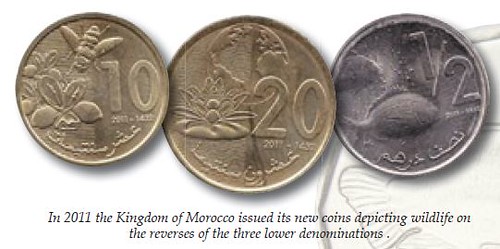
Downsizing?
The fourth, very noticeable, trend, is that coins are getting smaller, thinner and lighter. Artists complain that the resultant lower relief makes it
technically more diffi cult to produce a satisfying design. This all comes down to cost. As metals rise in price, so mints want to use them in
smaller quantities, or else they use cheaper metals, which are then plated in order to produce coins of the desired colour. Some countries resist
this trend, notably mineral-rich Australia, whose huge 50 cents coin—31.5mm in diameter and weighing over 15 grams—buys you very little these
days.
The inner polygonal rim
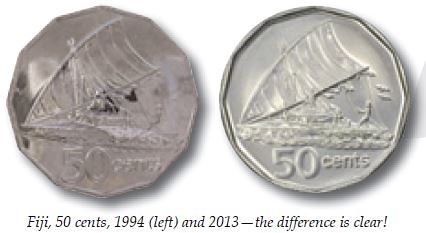
Bimetallics rule, OK?
The sixth trend is the continuing rise of the bimetallic coin. It has a long history, but as a circulation coin it was commonly seen only from the
end of the 1980s onwards. The French adopted it for their 10 francs coin in 1988, and even post-Soviet Russia briefly introduced circulating
bimetallic 50 rouble and 100 rouble coins from 1992.
Hi-tech developments
The seventh trend is the increasing use of latent images and laser marks, as seen on this Canadian 2 dollar coin of 2012. Like bimetal, these
features help protect coins against forgery. Recently the UK Treasury and Royal Mint went further down that route, by announcing a new secure
bimetallic pound coin for 2017. The new coin is a product of iSIS, “Integrated Secure Identification Systems”, which incorporates three tiers of
banknote-strength security and can be authenticated via highspeed automated detection. The Mint claims that it possesses overt, covert and forensic
security features. In the near future perhaps every country’s high denominations will include such features. In this hi-tech age, it should be
possible to place forgery beyond the capabilities of the amateurs.
Goodbye to coins?
The eighth trend is the decreasing use of coins. If I travel by public transport here in London, I never use cash: I simply swipe my personal travel
card (the Oyster card). When the balance on my card falls below a certain amount, it is automatically topped up from my bank account. At
supermarkets, however, rather than proffering a credit or debit card, I prefer to use cash at the self-service checkout where, unlike a human, the
uncomplaining machine happily relieves me of my piles of unwanted pennies.
It is possible that in 20 years’ time coins will no longer be needed—at least in the technologically advanced countries. I have read that stamp collecting is in decline because fewer people use stamps in the age of the email. How long before technology sends coins along the same path?
For more information or to subscribe to Coin News, see:
http://www.tokenpublishing.com/coins.asp
ROSENBLUM AUCTION ACTION
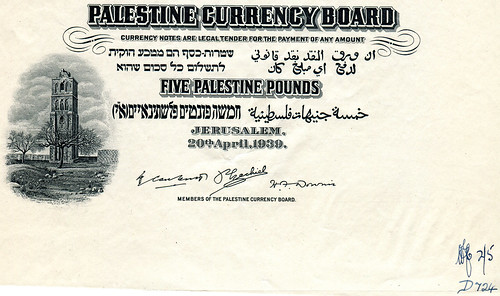
Our Fall 2014 auction is our best in over 44 years of issuing auction catalogs and price-lists. One of the finest collections of Israel and Palestine coins and paper along with other fine consignments. Please click on the link to the auction here .
Or call or email us. A limited number of printed paper catalogs are also available which we will make available to any E-Sylum reader gratis as long as our supply lasts.
SOME RECENT COINS DESIGNS: NOVEMBER 30, 2014
Belgium Higgs Boson 5 Euro Coin
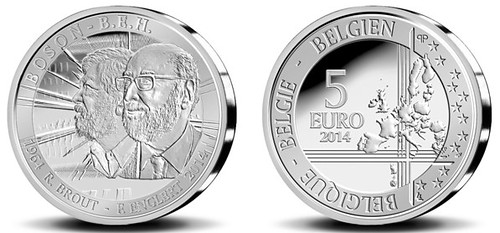
The coin is dedicated to two scientists who were part of the team that, 50 years ago, researched and postulated the existence of the Higgs Particle or BEH Boson.
The coin shows Robert Brout (1928–2011) and François Englert (1932–). The two worked at the Université Libre de Bruxelles. Englert got the Physics Nobel Prize last year, together with Peter Higgs.
The coin depicts a man who is still alive -- something that has never been done (except for the King and the Royal Family) so far.
Greece Gold 50 Euro Coin
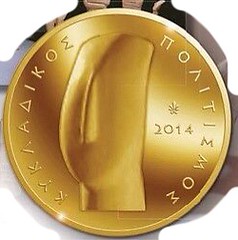

Pabitra Saha informs me that ...
The coin depicts a mask of Cycladic Civilization. Here is more about that Civilization: http://en.m.wikipedia.org/wiki/Cycladic_culture
Turkey Women's Basketball 20 Lira coin

Spain One and Two Euro Coins
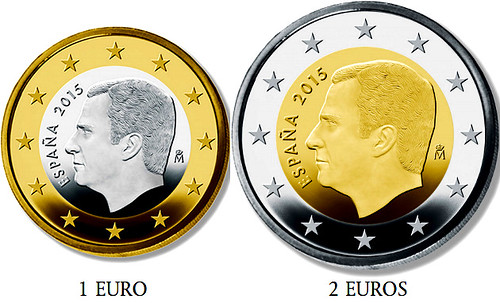
Latvia Four Seasons Five Euro Coin
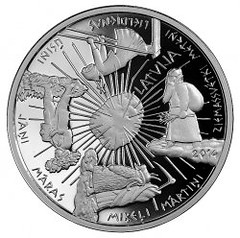
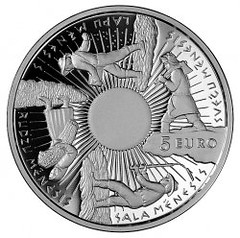
SRI LANKAN ADMINISTRATIVE DISTRICTS COINS
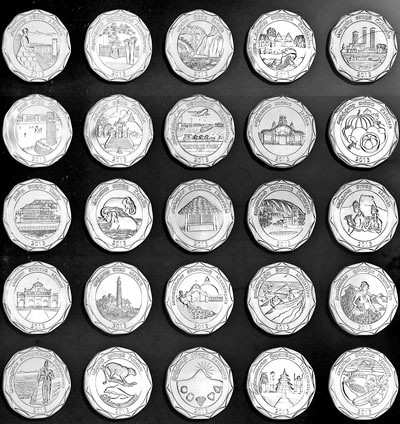
A new series of Ten Rupee coins representing Sri Lanka’s 25 districts was issued as a complete set by the Central Bank on Monday. The obverse designs depict one or more of unique archaeological, cultural, economic, environmental, religious or social characteristics of each district.
The project was started in August 2011 when CBSL issued a public notice inviting creative artists, to represent elegantly, the unique identity of each of the 25 districts. A cash prize of Rs. 50,000 was offered for each selected design.
The coins which will be issued into circulation at face value were also packaged to sell to collectors. There are three language versions of packaging with text printed in English, Sinhala or Tamil.
A commemorative folder of the complete set of 25 coins is displayed in a 5×5 array in English Alphabetical order. Standard reverse of one coin exposed at back gives the coin specifications. The folder was issued both in a sleeve for Rs. 1,000 and a presentation box for Rs. 2,000.Individual cards (3.5×2.25 inch) with one coin of a district each costs Rs. 50 while a set of 25 district cards costs Rs. 1,250.
A coffee table book for the set titled “Our People Our Potential Our Pride” printed only in English was also issued for Rs. 4,000.
To read the complete article, see:
One head and 25 tails
(www.sundaytimes.lk/141123/sunday-times-2/one-head-and-25-tails-129013.html)
Kavan adds:
See also my interactive website http://coins.lakdiva.org/d25/ for more details and high resolution images
STACK’S BOWERS ROCKWAY COLLECTION PART II
Stack’s Bowers Galleries is proud to announce the sale of The Rockway Collection Part II as part of its New York International Numismatic Convention (NYINC) auction, held January 9-10 and 12, 2015.
The collection consists of nearly 300 coins, primarily crowns and talers from Germany. A wide range of principalities, cities, states, duchies and bishoprics are represented. Among the coins are examples that are the finest certified for their respective types by the Numismatic Guarantee Corp.
The collection was assembled over several decades, from the 1960 to the 1990s, and the collector’s fascination with history — particularly European, American and Chinese — led to the formation of several important collections. After the collector’s recent passing, Stack’s Bowers Galleries was contacted by his family, who worked with Vicken Yegparian, vice president of numismatics. “The collection came in with the coins in old paper envelopes,” said Yegparian. “After the consignment was written up, I realized that not only was the breadth of the collection impressive, but many of the coins were in superlative condition.” Richard Ponterio, executive vice president added, “Not since our offering of The John S. Davenport Collection has there been such an impressive array of German crowns and talers. We are honored to present this collection to the current generation of numismatists, and are certain the coins will attract spirited bidding.”
“German coins are a very widely collected series,” noted Kent Ponterio, senior numismatist and consignment director at Stack’s Bowes Galleries. “The wonderful thing about this collection is that even with such an impressive assortment, the majority of the coins presented are within the budget of a large number of collectors. Large-size Mint State coins from the 17th and 18th centuries can be had for under a thousand dollars, in some cases. In addition, The Rockaway Collection also contains many important rarities, which will appeal to serious specialists of German coins.”
Highlights include:
Very Rare Bavaria Taler, 1657. Dav-6097; KM-300. NGC MS-62. Finest certified.
Superbly Toned Brandenburg-Bayreuth Taler, 1671. Dav-6273; KM-80. NGC MS-65. Finest certified.
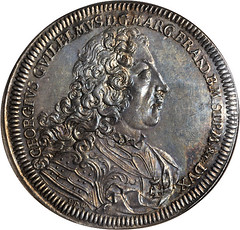
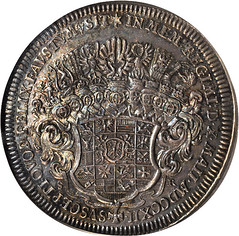
Very Rare Brandenburg-Bayreuth Taler, 1712-PPW SR. Dav-2031; KM-131. NGC MS-64. Beautiful and classic design.
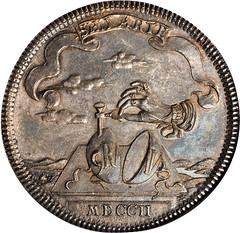
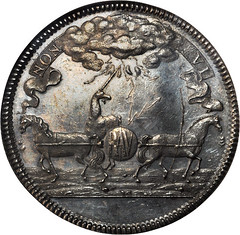
Impressive Medallic Brunswick-Wolfenbuttel Taler, 1702. Dav-2931; KM-641; Welter-2073b. NGC MS-61. Very rare. Allegorical scenes depict political strife in Brunswick following death of Augustus the Younger.
Beautiful Eichstatt Taler, 1757-MF. Dav-2208; KM -75. Sede Vacante issue. NGC MS-67*. Absolute finest graded by NGC, by three points.
Very Rare Proof Frankfort 2 Gulden, 1849. Dav-645; KM-341.1. NGC Proof-64. One of only 200 struck.
Exceptional Quality Fulda Taler, 1672. Dav-5316; KM-17. NGC MS-66. Very rare. Museum quality.
Prooflike Nurnberg Taler, 1711-GFN. Dav-2475; KM-275. NGC MS-64PL. Finest certified.
Museum Quality Prussia Taler, 1701-CS. Dav-2554a; KM-16. NGC MS-64. Rare, finest certified.
Rare Gem Saxony Albertine Line 2 Taler, 1733. Dav-2663; KM-872; Schnee-1023; Kahnt-620a. NGC MS-65. Struck to commemorate the death of Friedrich August I.
Well Struck and Lustrous Saxony Albertine Line Taler, 1696-IK. Dav-7653; KM-675; Schnee-987. NGC MS-64. Very Rare, struck to commemorate the birth of the Prince-Elector. Complex city view design.
Very Rare Commemorative Saxe-Weimar Taler, 1654. Dav-7545; KM-34; Schnee-404. NGC MS-63. Struck to commemorate the assumption of the Rectorship of Jena University by Duke Bernhard of Saxe-Weimar.
Rare and Desirable Trier Taler, 1715. Dav-2824; KM-218. NGC MS-64. Struck on the death of the Archbishop.
Very Rare Commemorative Proof Wurttemburg 3 Mark, 1916-F. KM-638. NGC Proof-63. One of the rarest silver minor coins of the era.
Aside from The Rockway Collection, the Stack’s Bowers Galleries Official Auction of the NYINC includes many other important collections, including The Ray Czahor Collection of Philippine Countermarked Coinage, The Stanley Aberdeen Collection, The John Adams Collection of Spanish Colonial Proclamation Medals, The Ancient Coins From The Richard Aghababian Collection, and further selections from The Demarete Collection. Other important properties include a fine selection of Spanish and American Administration Philippines coins, gold coins of Brazil, a wide range of coins from Russia, and a specialized collection of Judean coins.
For more information on this sale, or to request a catalog, contact a Stack’s Bowers Galleries associate at 800.458.4646 (West Coast), 800.566.2580 (East Coast), or email info@stacksbowers.com.
MORE COMMEMORATIVE MEDAL SELECTIONS FROM BALDWIN'S
Royal College of Surgeons

The Royal College of Surgeons, Gold Medal, awarded 1973 to Bruce Wilfred Goodman CBE, the College’s arms and supporters, rev by Thomas Pingo, Galen, standing in a landscape, contemplates a human skeleton, 47mm, 73.55g, 9ct gold, with scroll (cf Eimer, Pingo 41), as struck; together with his Royal College of Surgeon’s Patron’s Badge, cased, some chips to enamel. There is a strong numismatic link to this medal and scroll. The recipient was a serious coin collector in his own right, selling his collection to Baldwin in the 1960s. The President of the Royal College of Surgeons, Rodney Smith, later Lord Smith of Marlow, a signatory to the present scroll, was a significant collector of Charles I. His collection was bought privately by Spink and the Lord Smith of Marlow provenance is still a recognised and desirable provenance to this day.
To view the complete item description, see: Royal College of Surgeons. (www.baldwin.co.uk/royal-college-of-surgeons.html)
Celebrated Artists of Liège, 1886
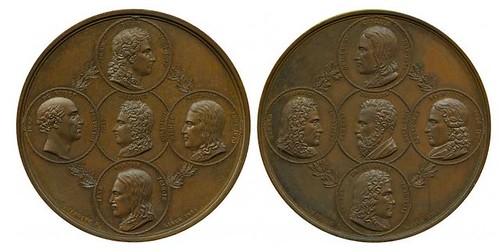
Belgium, Celebrated Artists of Liège, Bronze Medal by Jéhotte, 1886, medallic portraits of Carlier, Douffet, Lombard, Flemalle, de Lairesse, Varin, Du Vivier, Delcour, Natalis, and Valdor, 70mm. As struck.
To view the complete item description, see: Celebrated Artists of Liège, 1886 (www.baldwin.co.uk/celebrated-artists-of-liege-1886.html)
Naples and Caserta Railway, 1846
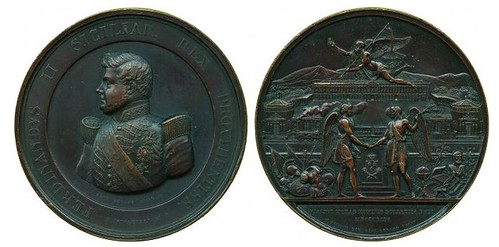
Italy, Ferdinand II of the Two Sicilies, the Inauguration of the Railway between Naples and Caserta, 1846, Bronze Medal by Arnaud, uniformed bust of Ferdinand left, FERDINANDVS II SICILIAR REX PROVIDENTIIS, rev Time flies over two Genii symbolizing War and Peace, in the distance the locomotive passes in front of the Palace of Caserta, in exergue, VIARVM MORAS HOMINIS SOLLERTIA VICIT MDCCCXLVI, 73mm (Riccardi 181). Nearly extremely fine.
To view the complete item description, see: Naples and Caserta Railway, 1846 (www.baldwin.co.uk/naples-and-caserta-railway-1846.html)
Germany, Karl Goetz, 1921

Germany, Regensburg, 100th Annivesary of Johann Jakob Rehbach’s pencil factory, 1921, Bronze Medal by Karl Goetz, bust of Rehbach almost facing, rev a boat in front of the Steinerner Bridge and the city of Regensburg, 1821-1921, 100mm (Kienast 126). Extremely fine.
To view the complete item description, see: Germany, Karl Goetz, 1921 (www.baldwin.co.uk/germany-karl-goetz-1921.html)
Prince of Wales, 1969
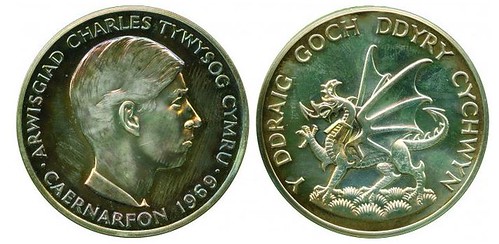
Elizabeth II, Investiture of the Prince of Wales, 1969, Silver Medal by M Rizzello, bust of Prince Charles right, ARWISGIAD CHARLES TYWYSOG CYMRU. CAERNARVON 1969, rev the Welsh Dragon, Y DDRAIG GOCH DDYRY CYCHWYN, 45mm, in case of issue (Eimer 2116b). As struck.
To view the complete item description, see: Prince of Wales, 1969 (www.baldwin.co.uk/prince-of-wales-1969.html)
To read the earlier article, see:
MORE COMMEMORATIVE MEDAL SELECTIONS FROM BALDWIN'S
(www.coinbooks.org/esylum_v17n48a15.html)
SELECTIONS FROM ROSENBLUM SALE #44B
American Jewish Joint Distribution Committee

336 Cyprus, American Jewish Joint Distribution Committee. (The Joint). 2 Shillings. Feller CY-1871, Campbell-5511, Haffner (1970) page 330, Schwan-Boling 241-243 (page 388). This is the Sylvia Haffner plate note but unlike the 1 and 5 Shillings notes which were damaged in a fire, this note just has lots of wear. This is the rare 1st issue which had the legend Good for purchase in the canteens in Cyprus or for exchange for cash in Jerusalem which the British found objectionable and was soon recalled and replaced by a 2nd issue. Of extreme rarity and importance with an impressive pedigree. After purchasing Mrs. Haffner’s collection, we sold this to the late Samuel Halperin (who unfortunately passed away this past Spring). Sam consigned it to us for our spring 2001 sale and it sold to “Mr. Philadelphia” as part of lot 832 in our sale 31C. All Cyprus Canteen Chits are extremely rare and desirable even in low grade. $750+?
Emergency Banknotes issued by B. Jacoby
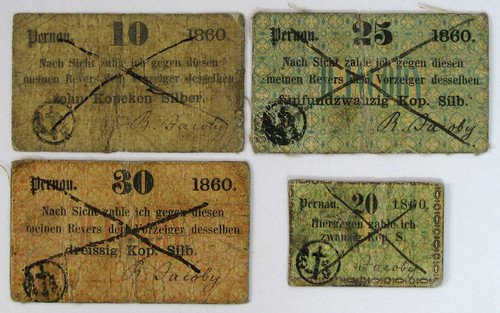
345 Estonia, Pernau. 1860. Four Emergency Banknotes issued by B. Jacoby. 10, 20, 25 and 30 Kopek. All cancelled with a handwritten X across the face and the signature of R. Jacoby at lower right. The notes have a round handstamp with a fancy RJ logo. These 4 notes, printed on colored cloth, are all low grade (VG-F). All have handwritten and barely visible serial numbers on the back and a few seem to have been repaired. Earlier this year two similar notes, but issued by B. Jacobi with the denomination stated as Copeks sold in the Money of the People Auction as part of the Neil Shafer collection. See The Shekel Vol. XXXVIII, #1, p. 43 for a similar note. Pernau is a city north of Riga and B. Jacoby was among a number of Jewish (and non-Jewish) merchants who issued these emergency notes (called notgeld in the 20th century) around that time in that area of Europe because of the scarcity of small change. These are from WMR 27c Lots 1140-1143. $750+?
Sachsenhausen Concentration Camp
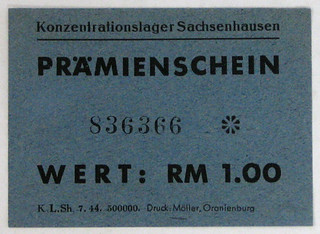
362 Germany, Sachsenhausen Concentration Camp. C-4062a (b), Feller-GE-291c, Grab-Haney Sa-2e.1 Mark Type 2 star (8 small wedges). Blue. Au-Unc. Scarce, seldom offered. Ex WMR 30c, #917 where it sold for $350. $400+?
Operation Bernhard Forgery
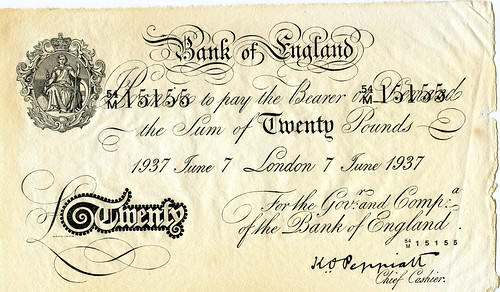
365 Great Britain, Operation Bernhard Forgery. P-337a, Camp-4067b, Feller GE-312b. £20 7 June 1937, London with signature of K. O. Peppiatt, aEF with small notch at right and the right margin is a bit rough. The notch on the right was purposely made to look like a genuine British note and it’s possible that the rough right edge was also done with the same intent. The 20£ and 50£ forgeries are the two scarcest denominations. A similar, but perhaps slightly nicer, note sold for $150 in our sale 42F. $125+?
Anglo-Palestine Bank

377 Israel, Anglo-Palestine Bank. P14, BN-1, APB B6a. 500 Mils Series A. Choice crisp EF. Bright and original, a very attractive exceptional note. $500+?
Warsaw Sugar Coupon

445 Poland, Warsaw. Sugar Coupon. 1916. Emergency World War I Money. For 275 grams of Sugar. Good in the 14th District of Warsaw. In German, Polish and Yiddish. Issued by the Jewish Community of Warsaw presumably sometime after the Germans entered Warsaw. Hand written endorsement on back. Date is handwritten on front of coupon. No doubt rare. F-VF. Ex 38D, #757. Emergency paper money for WWI is much scarcer than that of WWII. $75+?
King David Playing the Harp
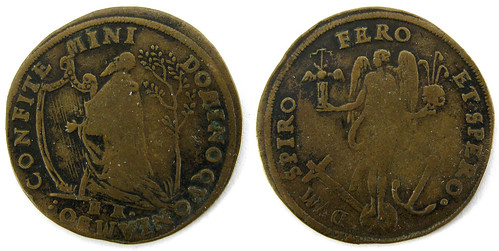
473 King David Playing the Harp. Hans Krauwinkel Biblical Jeton. ND (1590s?). Æ28.5 (5.00g). King David kneeling left playing the harp, tree behind him, HK in exergue/ Winged Angel standing upon a globe holding a winged hour-glass and a skull with flowers, crucifix to left, anchor to right. Mitchner-1629. F-VF. A rare Krauwinkel Biblical jeton that I cannot recall ever offering. $100+?
English Zionist Medal for the Coronation of Edward VII
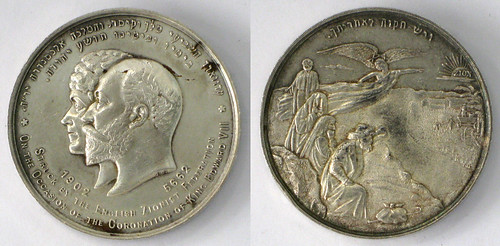
484 English Zionist Medal for the Coronation of Edward VII. 1902 Silver 41mm (46.27g) by R.N. (possibly R. Neal). Conjoined bare heads of Queen Alexandra and King Edward left, Hebrew legend above, the same in English below 1902 5622 Struck by the English Zionist Federation on the Occasion of the Coronation of King Edward VII/ Prophet with followers on mountain looking toward Zion in the distance, Angel of the Lord and Hebrew legend And there is hope for thy posterity above. In the wings of the angel is a Magen David. See The Shekel Vol. X, #6, p. 14. British Historical Medals (Brown) -3832. EF and a few spots. Very rare in silver. I’m not sure I’ve ever offered it in silver. If so, it’s been more than 25 years! $600+?
Italian Holocaust medal

504 Italian Holocaust medal. 1945. 32mm CN. Celebrating defeat of Nazis, struck by Jewish community of Milan. Menorah/Streak of lightning splitting axe with swastika. JTM HO-4. Unc. $50
For more information on the sale, see: http://rosenblumcoins.com/44b .

ARTICLE PROFILES CANADIAN COIN ARTIST TIM WHISKEYCHAN
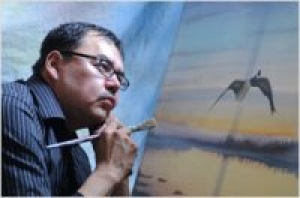 The Royal Canadian Mint will officially launch a new $5 silver coin Tuesday night featuring a design by Cree artist Tim Whiskeychan of Waskaganish in
northern Quebec.
The Royal Canadian Mint will officially launch a new $5 silver coin Tuesday night featuring a design by Cree artist Tim Whiskeychan of Waskaganish in
northern Quebec.
Whiskeychan's design depicts a traditional spring goose hunt. It's the fourth and final coin in the mInt's limited edition series, and the first time a Cree artist from Quebec has been commissioned by the mint for a collector coin series.
"What an honour," says Tim Whiskeychan. "I felt very happy and also overwhelmed because this is the first time for a Cree person from James Bay to have this special privilege to design a coin."
The image is of a Cree hunter in a caribou-skin coat, kneeling in the shore grass, aiming his bow and arrow at two geese flying overhead.
The spring hunt is an integral part of traditional Cree life and Whiskeychan says depicting it on a collectors' coin is one way to share Cree history.
"To have my design on a coin, you're preserving the old ways and it has a link to our people as well. It's history recorded. I'm deeply humbled."
Whiskeychan's murals and logos are featured on schools in his community, and he exhibits his watercolours and drawings informally throughout the Cree territory of Eeyou Istchee in Northern Quebec. But he says having his design on a piece of Canadian currency seems more permanent.
When he found out the Royal Canadian Mint had chosen his design, Whiskeychan's first thoughts were of his late father who lived on the land and who was well-known throughout Eeyou Istchee for making decorative tamarack goose decoys.
"The first thing that came to mind was my late father Harry who had a great influence on my life as an artist," he says.
"I remembered the days when my dad used to tell me 'Never quit art. Pursue what you do best.' And this is where I got to be."
The official launch of the $5 commemorative coin takes place Tuesday night in Ottawa.
To read the complete article, see:
Royal Canadian
Mint's $5 coin features work of Cree artist Tim Whiskeychan
(www.cbc.ca/news/aboriginal/royal-canadian-mint-s-5-coin-features-work-of-cree-artist-tim-whiskeychan-1.2849715)
HOW POLYMER BANKNOTES WERE INVENTED
 The Reserve Bank of Australia (RBA) and CSIRO’s 20-year “bank project” resulted
in the introduction of the polymer banknote – the first ever of its kind, and the most secure form of currency in the world.
The Reserve Bank of Australia (RBA) and CSIRO’s 20-year “bank project” resulted
in the introduction of the polymer banknote – the first ever of its kind, and the most secure form of currency in the world.
The project commenced in 1968 and continued until 1988 with the release of the A$10 bicentennial commemorative banknote. But it’s the story behind this story – a personal note of forgeries, underworld figures and CSIRO – that is just as impressive.
By April 1966 most of the old imperial banknotes had been removed from circulation, and a new range of state-of-the-art dollars and coins were doing the rounds of the nation’s tills, wallets and pockets. With designs by leading Australian artists and cutting edge security features such as watermarks and metal thread, things couldn’t have been better for the note-issuer, the RBA.
But the new notes were not infallible, and it didn’t take long for counterfeiters to strike.
By the end of the year, a team of amateurs from suburban Melbourne, armed with simple office equipment and a desire to make some money, were able to produce a batch of fake notes with no intaglio printing, no watermark and no metal thread that would net them almost A$800,000 worth of forgeries. (That figure’s not to be sneezed at – it would be worth A$9.6 million in 2013.)
The nucleus of this team were two “regular joes” with no real criminal history: Francis Papworth, an artist from Bentleigh, and Jeffrey Mutton, who owned a failing milk bar in Moorabbin near a printing plant where Papworth worked.
As with many great schemes, this one was hatched over a beer – Papworth and Mutton often met at the Boundary Hotel in East Bentleigh. It was January 1966, only a few weeks before the introduction of the dollar, and the two mates were looking for an easy way to reverse their fortunes. Papworth worked at a printing plant … so why not print some money?
News of the forgery soon became public, and a period of unrest followed. Instructions were issued by the Reserve Bank on how to spot the forgeries, which were then to be handed to authorities. But anybody turning a note in would not receive a genuine note in return, so many continued to be circulated.
A general distrust of A$10 notes permeated Australian society – at one stage, members of the Amalgamated Engineering Union refused to accept them as part of their pay packet.
The RBA’s Governor, HC (Nugget) Coombs turned to science – or, more specifically, to CSIRO. The challenge was set: could we create the world’s most secure banknote?
After some preliminary planning, the “bank project” began. Coombs originally enlisted seven top Australian scientists – five physicists and two chemists – to help the RBA develop a more secure banknote. They met on April 1, 1968, and despite the date, these were no April fools – the two chemists were Jerry Price, who went on to become chairman of CSIRO, and Sefton Hamann, chief of the CSIRO Division of Applied Chemistry.
The group was introduced to the general principles of banknote design and production, and sent off to think about it before reconvening for a second meeting at Thredbo in June 1968.
Two more scientists were invited to Thredbo: Neil Lewis, recently retired from Kodak, and David Solomon, a young, award-winning polymer scientist from CSIRO. It was during these first few years that Dr Solomon first hit on the idea of a plastic banknote after being given a business card printed on plastic by a visitor from Japan.
Today, there are more than 30 different denominations totalling some three billion polymer notes in service in 22 countries worldwide.
To read the complete article, see:
Proceeds of crime: how polymer banknotes were
invented (theconversation.com/proceeds-of-crime-how-polymer-banknotes-were-invented-34642)
BLOWING ON BANKNOTES TO SEE IF THEY'RE GOOD
Scientists are working on an easier way to detect counterfeit money—and they have beetles to thank for it. The system, which would allow people to reveal counterfeit cash by breathing on it, is based on the ability of a longhorn beetle species to change color based on local humidity, Chemistry World reports. Researchers in China are working on an inexpensive inkjet printing technology that works similarly; the ink adsorbs nearby vapors, including those in our breath, and changes color in response. "It is particularly refreshing to see simple techniques such as inkjet printing being used to such great effect," says an outside expert.
Comparable research appeared a few months ago, when scientists in Michigan and South Korea revealed a film which, when touched by breath, reveals images or words. That technology could be used to fight the creation of items like fake passports, Wired reported; blowing on the passport could make a special logo appear, for instance. While it's expensive and difficult to create the equipment behind the film—perhaps deterring counterfeiters—it's cheap to produce the stuff once the gear is up and running, Gizmodo reported.
To read the complete article, see:
In the Future, Blowing on Cash Could
Reveal If It's Counterfeit (www.newser.com/story/198824/in-the-future-blowing-on-cash-could-reveal-if-its-counterfeit.html)
NIGERIAN MUSLIMS IRKED BY BANKNOTE
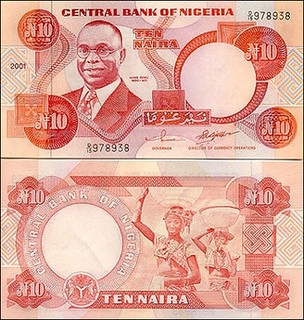 A
new Nigerian banknote that removed an inscription written in Arabic letters has drawn the ire of the country's Muslim community, with activists
linking the note's design to President Goodluck Jonathan's alleged disregard for Muslims – an assertion the presidency denies.
A
new Nigerian banknote that removed an inscription written in Arabic letters has drawn the ire of the country's Muslim community, with activists
linking the note's design to President Goodluck Jonathan's alleged disregard for Muslims – an assertion the presidency denies.
"The removal of the Arabic inscription, which is written in a language known in Nigeria's north as 'Ajami,' from the new naira note is very unfortunate," Khalid Aliyu, spokesman for the Muslim apex body Jama'atu Nasrul Islam (JNI), told The Anadolu Agency.
"This [the new note] is a slap on the face of the Muslims and a total disregard for their rights. We feel very strongly about this," Aliyu said, noting that, on the new note, the Ajami had been replaced with a symbol that some say resembles a six-pointed star, a sign associated with Israel.
President Jonathan recently unveiled a new 100-naira currency note, which does not contain the inscription in Arabic letters featured on the old one, but still contains the name of the money in Nigeria's three major languages: Igbo, Yoruba and Hausa. Use of the Ajami language, which is a local Hausa dialect that uses Arabic letters, predates the arrival of the British in Nigeria.
Frequently used in the country's majority-Muslim north, it is said that most of the African continent's pre-colonial history was written in Ajami.
Yet Jonathan spokesman Reuben Abati dismissed the allegations, denying the existence of any religious motivations behind the design of the new currency. "The proposed new naira note has nothing to do with religion whatsoever. It is completely wrong to accuse President Jonathan of being anti-Islamic on the basis of the design of the naira. He is the president of everybody, whatever may be their religious persuasion," Abati told AA.
To read the complete article, see:
Nigerian Muslims irked by new
'anti-Islamic' banknote (www.worldbulletin.net/world/149352/nigerian-muslims-irked-by-new-anti-islamic-banknote)
THE BOOK BAZARRE
THE SS CENTRAL AMERICA'S BIOLOGICAL TREASURE
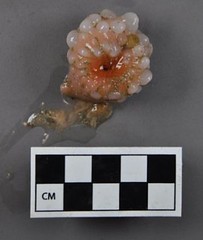 The greatest treasure of all in the SS Central America shipwreck off the South Carolina coast might not be gold bars and coins worth millions of
dollars.
The greatest treasure of all in the SS Central America shipwreck off the South Carolina coast might not be gold bars and coins worth millions of
dollars.
Microscopic organisms in the sediment below the wreck might reap a different kind of treasure — one that could save lives.
That’s the hope of research scientist Michael Lawman, whose Tampa biotech company Morphogenesis is sifting through the sediment in hopes of finding microorganisms that could one day help treat cancer and other diseases.
Lawman is one of several scientists who used last summer’s probe of the 19th century shipwreck by Odyssey Marine Exploration to obtain samples from the deep ocean floor. As is the case with many scientists, Lawman can’t afford a ship and equipment to dig up sediment, so he relies on expeditions such as Odyssey’s.
“It’s a different kind of treasure than Odyssey usually looks for,” Lawman said. “Our interest is in the microorganisms in the ocean and in the seabed itself.
“We want to isolate those bacteria and see the processes they have to (help them) live in a very harsh environment.”
Morphogenesis researchers will analyze the sediment and try to grow colonies of the bacteria that inhabit it. If the colonies appear to be new bacteria, “We’ll chase it to see what allows it to live at 7,000 feet” in the ocean, Lawman said.
From there, they’ll work to determine whether the bacteria could have medicinal uses.
The company already has found organisms from shallower ocean sediment with properties that could target cancer and infectious diseases. The SS Central America sediment is the deepest they’ve obtained.
The potential, Lawman said, is huge.
Overseeing the shipwreck samples is Bob Evans, chief scientist for Recovery Limited Partnership, the Columbus-based company that hired Odyssey this past spring to salvage treasure from the shipwreck.
Evans was involved in the original, successful search for the Central America in the late 1980s. That group pulled up gold, silver, artifacts and sea creatures, but was derailed by decades of lawsuits and management problems.
The new effort is led by Ira Owen Kane, the court-appointed receiver for Recovery Limited.
“This natural environment is so unknown,” Evans said. “The prime purpose of the expedition is the recovery of treasure, but in the course of that, we shouldn’t ignore the opportunity for this huge scientific opportunity.”
Odyssey uses a remotely operated vehicle called Zeus, which is lowered into the ocean from the ship and collects gold, artifacts and marine samples.
Zeus sucks animals and sediment with a vacuum attachment. Samples are placed in containers that are returned to the surface, where they are catalogued and preserved.
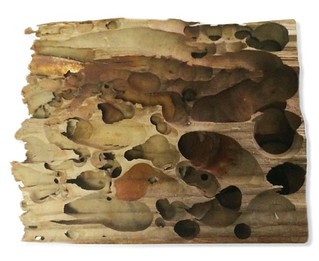 This past summer, Evans observed the results of an experiment he had left at the shipwreck site in
1990 — 3-foot-long blocks of wood, some pine and others oak.
This past summer, Evans observed the results of an experiment he had left at the shipwreck site in
1990 — 3-foot-long blocks of wood, some pine and others oak.
The idea was to determine how quickly the wood — the same kind used to build the Central America — would disintegrate. “I thought the wood would have maybe a 50-year life,” Evans said.
Instead, when Zeus pulled up the 4-inch-by-4-inch blocks, only a few inches remained.
A type of clam apparently had burrowed into the wood. None of the creatures remained, however, much to Evans’ disappointment.
To read the complete article, see:
Sea organisms from shipwreck could be real treasure to
researchers (www.dispatch.com/content/stories/local/2014/11/23/scientific-gold.html)
HOW STUART LITTLE RESCUED A LOST PAINTING
 A long-lost avant-garde painting has returned home to Hungary after nine decades thanks to a
sharp-eyed art historian who spotted it being used as a prop in the Hollywood film "Stuart Little".
A long-lost avant-garde painting has returned home to Hungary after nine decades thanks to a
sharp-eyed art historian who spotted it being used as a prop in the Hollywood film "Stuart Little".
In 2009 Gergely Barki, a researcher at Hungary's National Gallery, noticed "Sleeping Lady with Black Vase" by Robert Bereny (1888-1953) in the 1999 kids' movie about a mouse as he watched TV with his daughter Lola.
"I couldn't believe my eyes when I saw Bereny's long-lost masterpiece on the wall behind Hugh Laurie, I nearly dropped Lola from my
lap," Barki, 43, told AFP on Thursday.
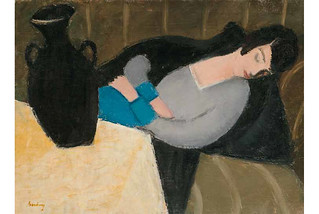 "A
researcher can never take his eyes off the job, even when watching Christmas movies at home," he said.
"A
researcher can never take his eyes off the job, even when watching Christmas movies at home," he said.
The painting disappeared in the 1920s but Barki recognised it immediately even though he had only seen a faded black-and-white photo dating from a 1928 exhibition archived in the National Gallery.
Barki sent a flurry of emails to staff at the film's makers Sony Pictures and Columbia Pictures, receiving a reply from a former Sony employee, a set designer -- two years later.
"She said the picture was hanging on her wall," Barki told AFP.
"She had snapped it up for next-to-nothing in an antiques shop in Pasadena, California, thinking its avant-garde elegance was perfect for Stuart Little's living room."
After leaving Sony the set-designer sold the painting to a private collector who has now brought the picture to Budapest for auction.
To read the complete article, see:
'Stuart
Little' helps lost Hungarian painting come home after nine decades
(artdaily.com/news/74651/-Stuart-Little--helps-lost-Hungarian-painting-come-home-after-nine-decades-#.VHiMtTEVhYE)
PAINTING DEPICTS CHILD WITH COIN
John Sallay writes:
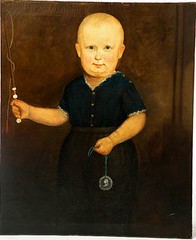 A
heads up on an auction lot for E-Sylum readers. The pictured medallion/medal/coin (or whip…) might be of interest to someone for their
collection.
A
heads up on an auction lot for E-Sylum readers. The pictured medallion/medal/coin (or whip…) might be of interest to someone for their
collection.
I don’t immediately recognize the piece, but it may be a capped bust half dollar painted with some artistic license. By the way, I believe that the estimate may be very low given that early American folk paintings of children continue to be popular.
For more information see the full lot description at:
Lot 499: PORTRAIT OF A CHILD
(AMERICAN SCHOOL, MID 19TH CENTURY). (www.invaluable.com/auction-lot/portrait-of-a-child-american-school,-mid-19th-ce-499-c-dd9e45bd83)

SLATE ARTICLE ON PURRINGTON'S U.S. PAPER MONEY
Eric writes:
Interesting concepts though I suspect that unless we start outsourcing to De La Rue this would not fly at the BEP. Plus the whole "look and feel" as a counterfeiting deterrent would also rule them out. That said I do like seeing design concepts like this as exercises in currency development.
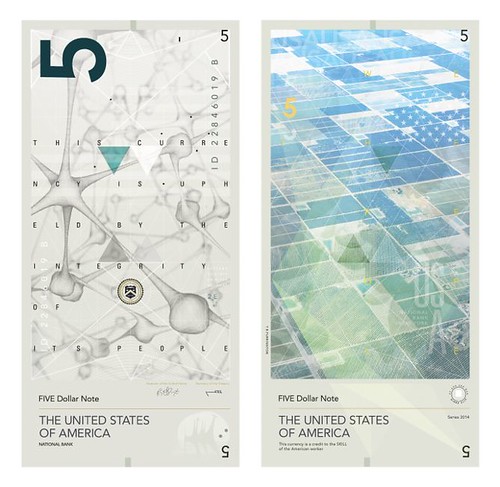
Purrington first researched the historical evolution of the U.S. dollar, concluding that the tradition of experimentation and exploration within U.S. currency history had stagnated in the last 80-plus years. “I simply wanted to introduce the idea that there is still room to grow and innovate in U.S. culture with currency,” he said.
But is there really a chance that the U.S. would redesign the dollar bill?
“I’m not declaring that this proposal is a suitable replacement for the USD as much as I’m suggesting that one could exist,” he said. “But we simply don’t know because those gates are closed pretty tightly.” Purrington said that his proposal is not ultramodern—it’s still traditional paper-based currency. The idea, he said, is “transitional,” and he never considered it realistic. “I’ve taken great liberties with terminology and design elements that wouldn't survive the bureaucracy or banking structure. It is more relevant to say that this is a conceptual system.”
To read the complete article, see:
What Would a Redesigned
U.S. Dollar Look Like? (www.slate.com/blogs/the_eye/2014/11/20/travis_purrington_volunteers
_to_redesign_the_u_s_dollar_bill.html)
To read the earlier E-Sylum article, see:
DESIGNER PURRINGTON REIMAGINES U.S. PAPER MONEY
(www.coinbooks.org/esylum_v17n45a31.html)
2003 LIBERTY PLATINUM GUITAR PICK
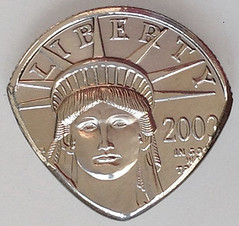
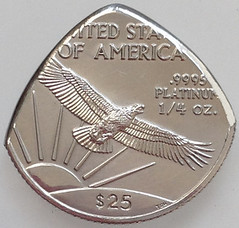
This beautiful Coin Guitar Pick is made from very rare solid platinum. This is nearly a quarter ounce of platinum, and will be the perfect addition to your boutique or hand built guitar!
To order yours, see:
2003 Liberty Platinum Solid .9995
(www.coinguitarpicks.com/2003-Liberty-Platinum-Solid-9995-Platinum-Solid-9995-2003-Libert.htm)
LITHUANIA BUILDS WORLD'S LARGEST COIN PYRAMID
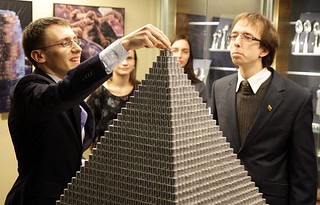 The
Baltic nation of Lithuania on Saturday unveiled what it billed as the world's largest-ever coin pyramid ahead of its switch from the litas
currency to the euro on January 1.
The
Baltic nation of Lithuania on Saturday unveiled what it billed as the world's largest-ever coin pyramid ahead of its switch from the litas
currency to the euro on January 1.
Volunteers spent nearly three weeks arranging one million coins, worth 10,000 litas (2,900 euros), into a pyramid over one metre (yard) tall.
"We have certainly beaten the world record. Previously, the biggest pyramid of this kind was made up of 600,000 coins", said 26-year-old volunteer Domas Jokubauskis.
All the coins will eventually be donated to a children's charity.
The Baltic nation of three million, which joined the EU in 2004, will become the 19th member of the eurozone on January 1, 2015.
The litas helped to consolidate Lithuania's statehood on the two occasions it restored independence from Moscow, in 1918 and 1990.
The new euro coins will still feature the national coat of arms -- featuring a knight on horseback with a sword and shield -- which has identified the country's currency since the 14th century.
To read the complete article, see:
Lithuania Just Made The Largest Coin Pyramid
Ever (www.businessinsider.com/afp-lithuania-builds-worlds-largest-coin-pyramid-2014-11)
FEATURED WEB SITE: JAMAICA CURRENCY
This week's Featured Web Site is the Bank of Jamaica's "History of our Currency"Up until the early 16th century, when the Spaniards colonized Jamaica, there had been little occasion for the use of a regular currency. Although there was a small amount of gold on the; island, the Taino Indians, Jamaica's first inhabitants, used it; for decorative purposes rather than for trade, which was conducted by barter.
The first units of exchange used by the Spaniards (who came with Columbus in 1494) in their dealings with the Tainos, were items such as glass beads and trinkets, scissors and mirrors.

http://boj.org.jm/currency/currency_history.php


